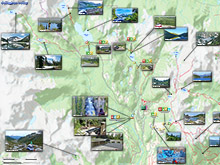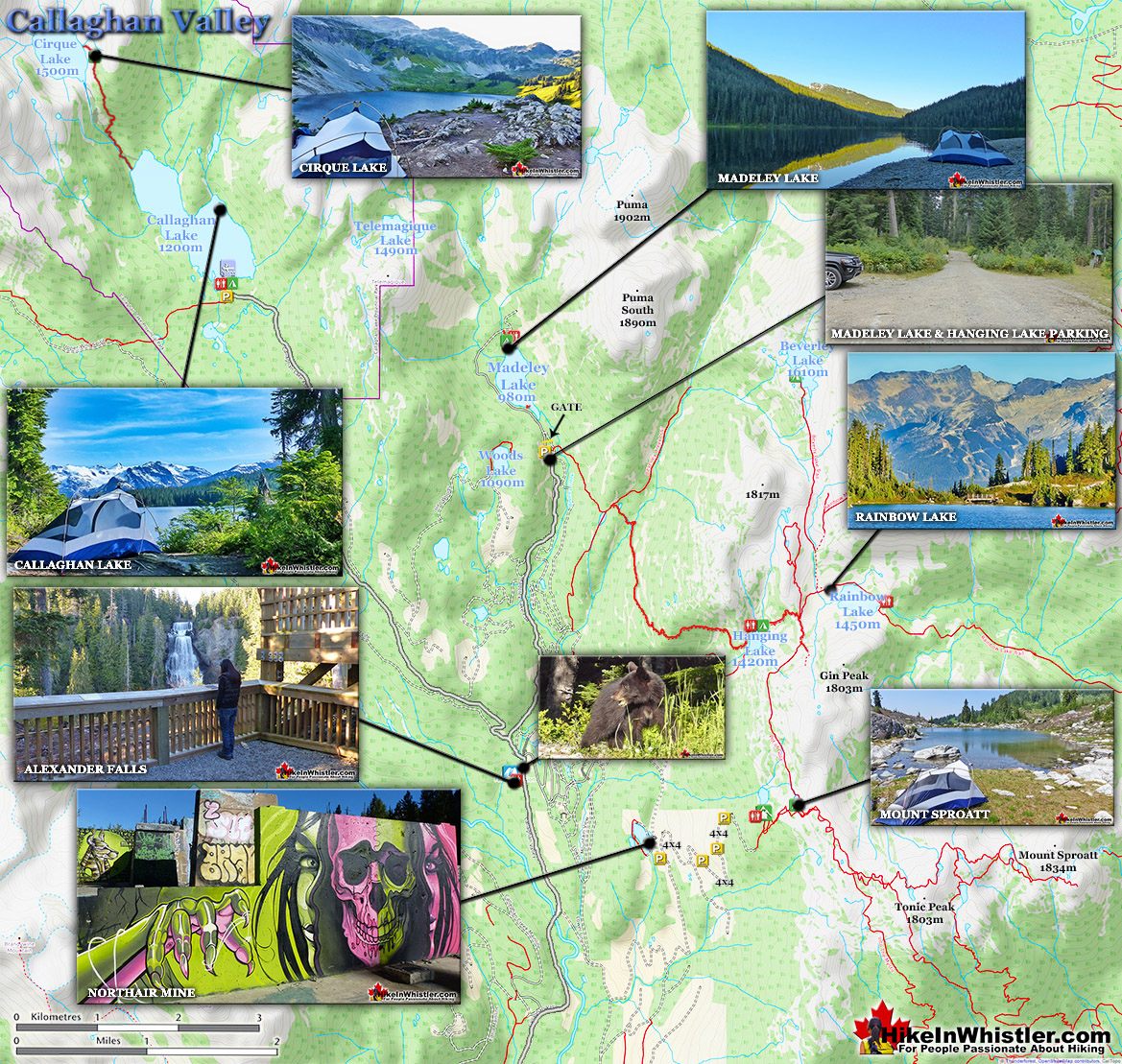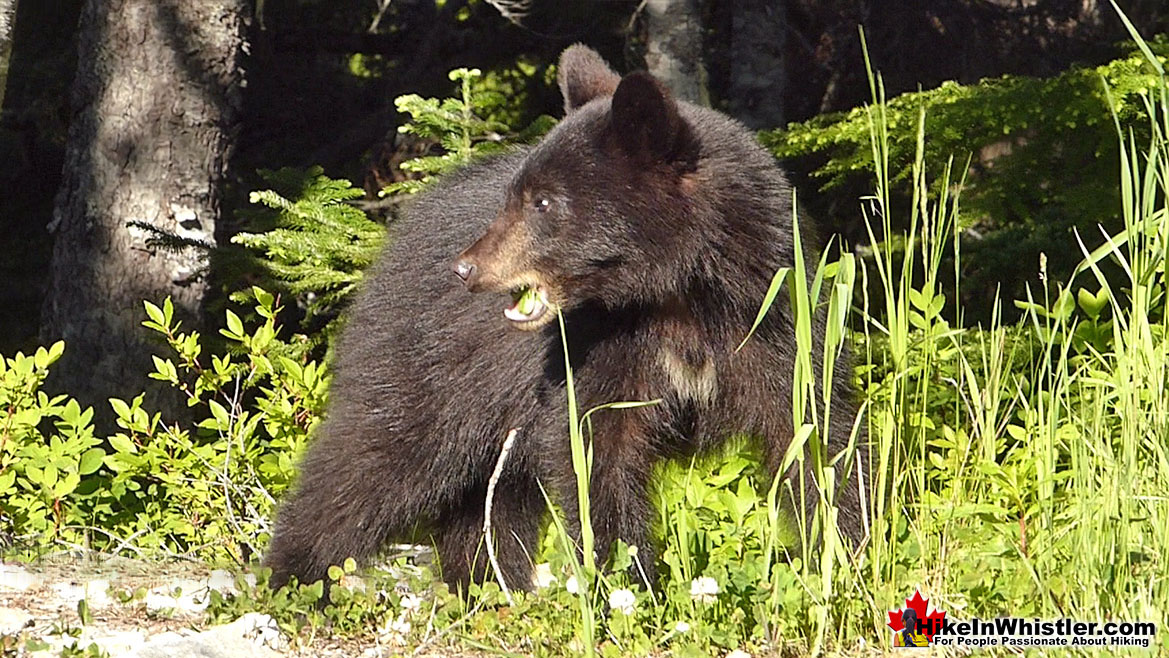
![]() Cirque Lake is a wild and beautiful lake that hides high above and beyond Callaghan Lake in Callaghan Lake Provincial Park. What makes Cirque Lake special among the other sensationally beautiful lakes in the Whistler area is both its location and geologically formed shape. It sits high above Callaghan Lake, which itself is a gorgeous, mountain lake. The remoteness of Callaghan Lake is a bit of a mirage due to the fact that you can drive right to it!
Cirque Lake is a wild and beautiful lake that hides high above and beyond Callaghan Lake in Callaghan Lake Provincial Park. What makes Cirque Lake special among the other sensationally beautiful lakes in the Whistler area is both its location and geologically formed shape. It sits high above Callaghan Lake, which itself is a gorgeous, mountain lake. The remoteness of Callaghan Lake is a bit of a mirage due to the fact that you can drive right to it!
 Infrequently hiked & relatively untouched
Infrequently hiked & relatively untouched Stunningly beautiful lake created by glaciation
Stunningly beautiful lake created by glaciation Endless alpine terrain to explore beyond the lake
Endless alpine terrain to explore beyond the lake The cirque acts a shield against the cold mountain winds
The cirque acts a shield against the cold mountain winds The side of the cirque you will be on is always sunny
The side of the cirque you will be on is always sunny You feel like you are in a hidden world in the mountains
You feel like you are in a hidden world in the mountains Starting your hike from a canoe is fun
Starting your hike from a canoe is fun Callaghan Lake is a destination on its own
Callaghan Lake is a destination on its own The drive to Callaghan is beautifully scenic
The drive to Callaghan is beautifully scenic Few flat areas to put up a tent & cold swimming!
Few flat areas to put up a tent & cold swimming!
Whistler & Garibaldi Hiking
![]() Alexander Falls
Alexander Falls ![]() Ancient Cedars
Ancient Cedars ![]() Black Tusk
Black Tusk ![]() Blackcomb Mountain
Blackcomb Mountain ![]() Brandywine Falls
Brandywine Falls ![]() Brandywine Meadows
Brandywine Meadows ![]() Brew Lake
Brew Lake ![]() Callaghan Lake
Callaghan Lake ![]() Cheakamus Lake
Cheakamus Lake ![]() Cheakamus River
Cheakamus River ![]() Cirque Lake
Cirque Lake ![]() Flank Trail
Flank Trail ![]() Garibaldi Lake
Garibaldi Lake ![]() Garibaldi Park
Garibaldi Park ![]() Helm Creek
Helm Creek ![]() Jane Lakes
Jane Lakes ![]() Joffre Lakes
Joffre Lakes ![]() Keyhole Hot Springs
Keyhole Hot Springs ![]() Logger’s Lake
Logger’s Lake ![]() Madeley Lake
Madeley Lake ![]() Meager Hot Springs
Meager Hot Springs ![]() Nairn Falls
Nairn Falls ![]() Newt Lake
Newt Lake ![]() Panorama Ridge
Panorama Ridge ![]() Parkhurst Ghost Town
Parkhurst Ghost Town ![]() Rainbow Falls
Rainbow Falls ![]() Rainbow Lake
Rainbow Lake ![]() Ring Lake
Ring Lake ![]() Russet Lake
Russet Lake ![]() Sea to Sky Trail
Sea to Sky Trail ![]() Skookumchuck Hot Springs
Skookumchuck Hot Springs ![]() Sloquet Hot Springs
Sloquet Hot Springs ![]() Sproatt East
Sproatt East ![]() Sproatt West
Sproatt West ![]() Taylor Meadows
Taylor Meadows ![]() Train Wreck
Train Wreck ![]() Wedgemount Lake
Wedgemount Lake ![]() Whistler Mountain
Whistler Mountain
![]() January
January ![]() February
February ![]() March
March ![]() April
April ![]() May
May ![]() June
June ![]() July
July ![]() August
August ![]() September
September ![]() October
October ![]() November
November ![]() December
December
Callaghan Lake is accessible via an 8 kilometre weather battered and very potholed forest service road. The entire road is cratered with deep potholes, cut by frequent cross-ditches, and more recently a small section collapsing into the valley below. This logging road begins high up in the Callaghan Valley, which itself is largely overlooked by travellers to Whistler. The Callaghan Valley is home to quite a few natural and man-made attractions. Brandywine Meadows, Alexander Falls, Northair Mine and Mount Sproatt are all found in the valley. Recently, the 2010 Olympic Games produced the largest man-made attraction in Callaghan Valley, Whistler Olympic Park. Though Cirque Lake is tremendously far into the wilderness, the amount of hiking required to reach it is effectively less than two kilometres. Another two kilometres of canoeing is required to reach the trailhead at the far end of Callaghan Lake. But for such an enchantingly beautiful, mountain lake, the exertion to reach it is remarkably little. The other attribute of Cirque Lake that makes it special, is its cirque structure. From the moment you catch sight of Cirque Lake, the abruptly steep sides all around give you the humbling feeling that you are inside a volcano. A volcano filled with emerald water and ringed by grassy meadows and crumbling, near vertical cliffs. Where you stand, at the entrance to the cirque, is not far from the only water channel out of the cirque. An ever narrowing gap in the cliffs spills water down one cliff after another until reaching Callaghan Lake just 1.4 kilometres away.
Cirque Lake Sunset Aerial View
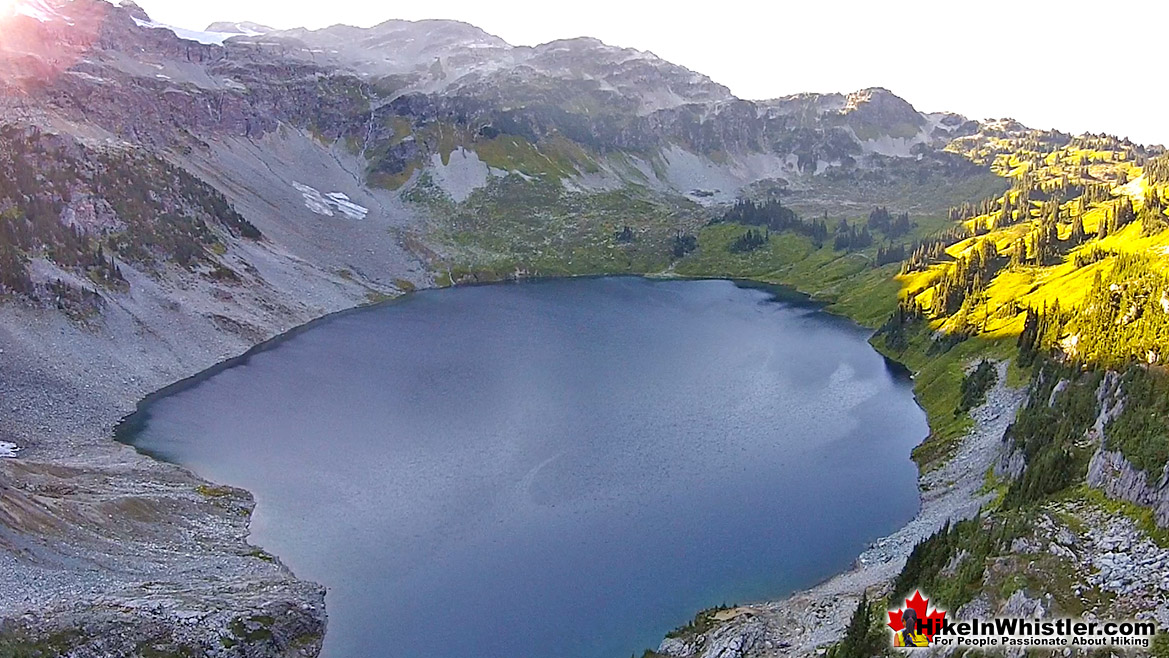
Cirque Lake Tent Site
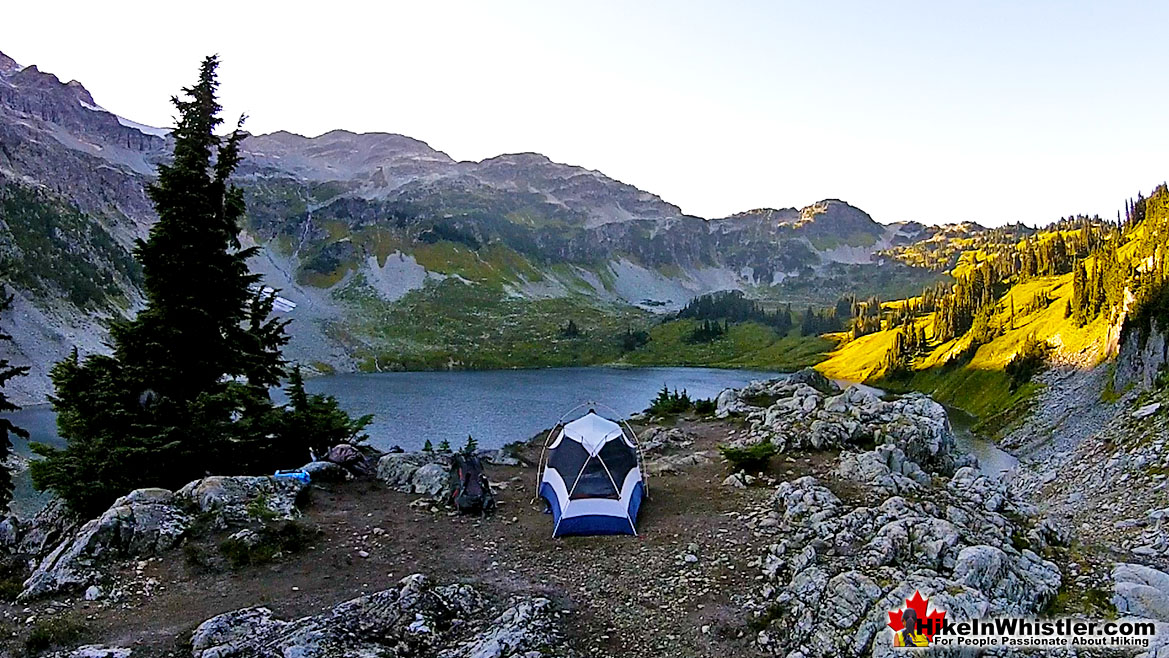
Cirque Lake Partly Frozen in July

Cirque Lake Swimming View
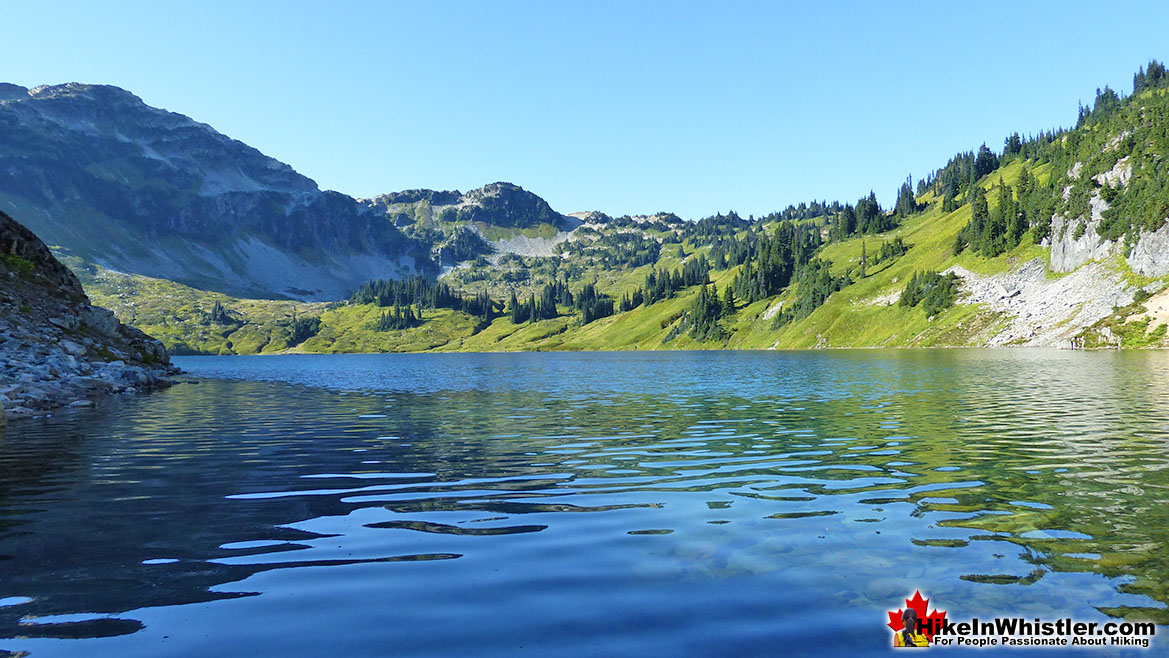
Aerial View of Cirque Lake
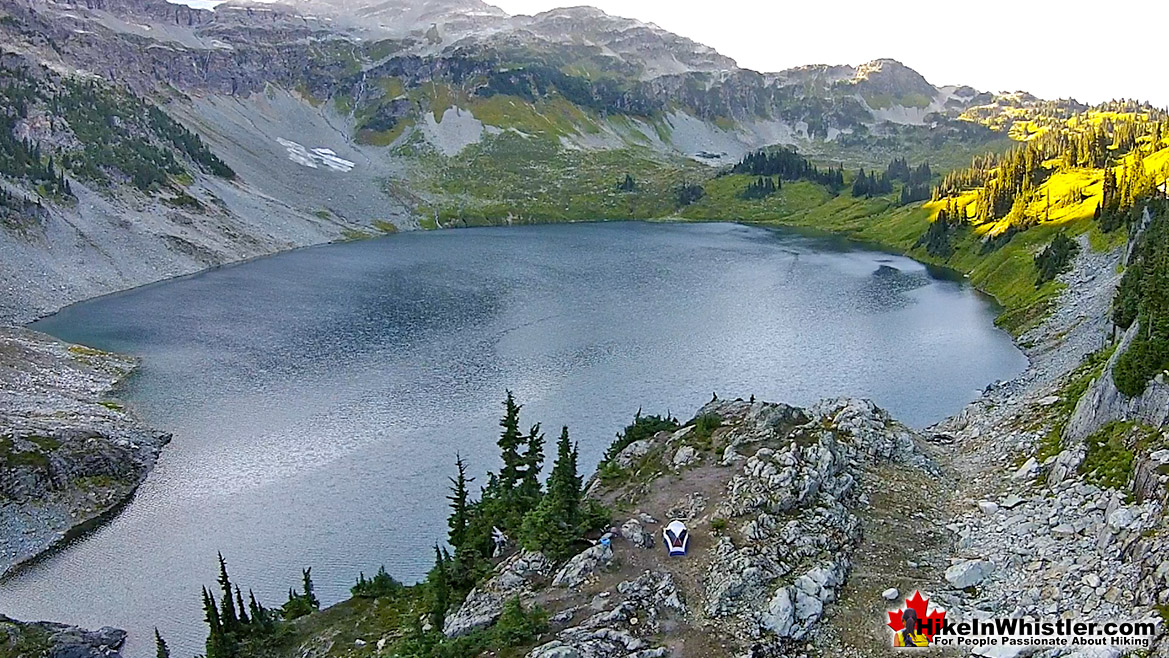
Boat Access to Cirque Lake Trailhead
Owing to the fact that you have to reach the trailhead to Cirque Lake by boat ensures that it almost always remains deserted. Even in the middle of summer, your tent will almost certainly be the only one that resides in this magical cirque. You sometimes get hikers venturing up from their campsites at Callaghan Lake for a couple hours, otherwise nobody. One feature of the Cirque Lake trail that no doubt scares hikers away is its steepness and ruggedness. It is mostly very steep, and due to the obliterating effects of winter snow, the trail markers are sporadic at best. One consolation is of course the length of the trail. Under two kilometres, makes the steepness much easier to tackle. With a heavy pack you can easily hike the trail in a little over an hour. Or an hour and a half or two if you linger at the frequent viewpoints looking back on Callaghan Lake. The eruption of blueberry bushes in August is cause for some delays as well as it is surprisingly hard to pass up feasting on every bush you see.. and you will see a lot. The trail, for the most part is quite scenic and enjoyable. The first 15 minutes of the trail winds through a cute forest along and over some small streams. The next 15 minutes takes you up some steeper and more challenging terrain that require pulling yourself up with tree roots and at one section a knotted rope. Thirty minutes into the trail brings you to a massive boulder field that you have to budget your attention between the treacherous boulders ahead and the incredible views of Callaghan Lake behind. The final 15 minutes of the trail is the most enjoyable of all. Summiting the ridge that takes you to the access point entrance to Cirque Lake. This ridge has a clearing with breathtaking views overlooking Callaghan Lake. So beautiful that you will be tempted to drop your pack and spend the night. The real marvel of course lays just 5 minutes ahead.
Cirque Lake Trail Steep Boulder Field
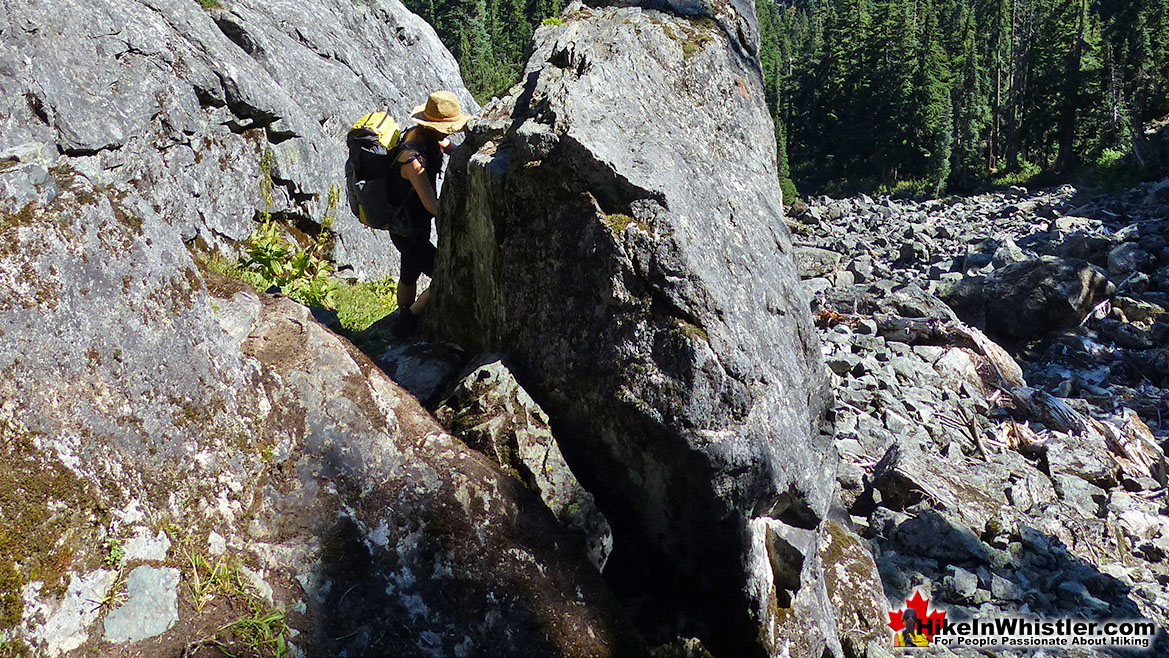
Cirque Lake Trail View of Callaghan Lake

First View of Cirque Lake
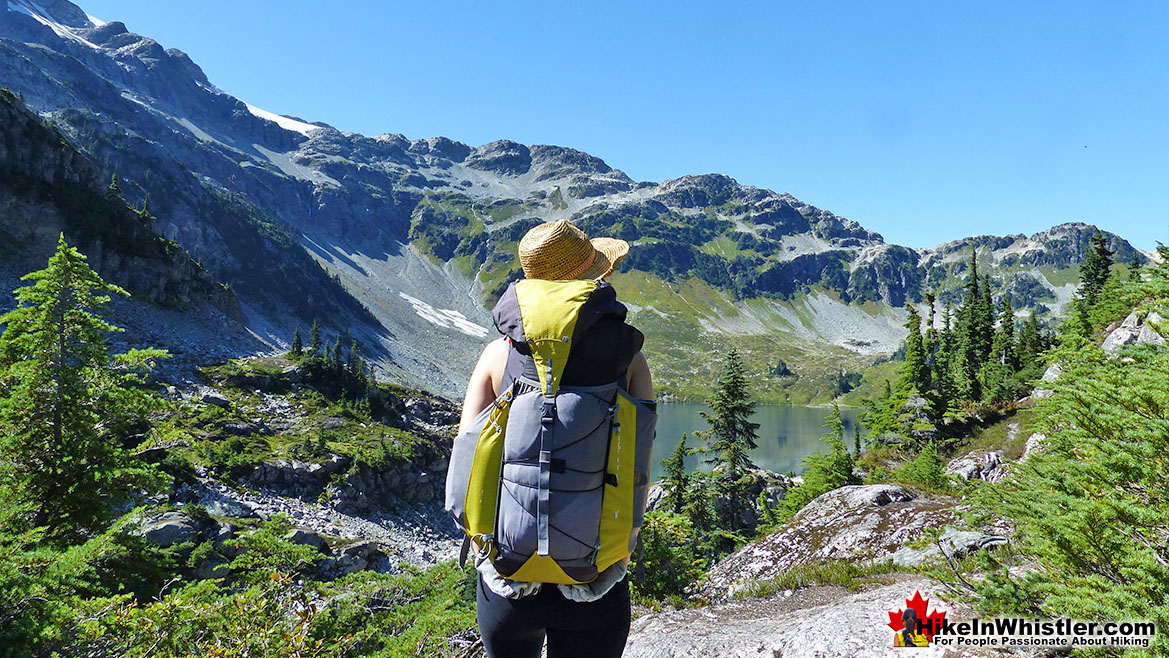
The Cirque Lake Trail
![]() The parking area for Cirque Lake is the parking area for Callaghan Lake Provincial Park. There are no parking or camping fees in the park and even if the campsites are busy, you will always be able to find a place to park your car. Callaghan Lake Provincial Park is centred around this large camping and parking area at the edge of Callaghan Lake. Each campsite is designed with a tidy fire ring and sectioned off with rows of rocks. Campers generally park their car next to where the put up their tent. This sometimes leads to some loud campsite parties to erupt. As you drive into the campsite/parking area you will drive straight into the gravel slope that works as a functional boat launch. You can drop your canoe directly into the water from your roof racks, then park just a few metres away. Callaghan Lake Provincial Park is wonderfully free of pointless signs, so you won’t find a dedicated parking area or no parking areas. Just use your common sense and find a spot not directly adjacent to a camping area or it will look like the campsite has been occupied by you.
The parking area for Cirque Lake is the parking area for Callaghan Lake Provincial Park. There are no parking or camping fees in the park and even if the campsites are busy, you will always be able to find a place to park your car. Callaghan Lake Provincial Park is centred around this large camping and parking area at the edge of Callaghan Lake. Each campsite is designed with a tidy fire ring and sectioned off with rows of rocks. Campers generally park their car next to where the put up their tent. This sometimes leads to some loud campsite parties to erupt. As you drive into the campsite/parking area you will drive straight into the gravel slope that works as a functional boat launch. You can drop your canoe directly into the water from your roof racks, then park just a few metres away. Callaghan Lake Provincial Park is wonderfully free of pointless signs, so you won’t find a dedicated parking area or no parking areas. Just use your common sense and find a spot not directly adjacent to a camping area or it will look like the campsite has been occupied by you.
Callaghan Lake Campsite, Parking and Boat Launch

Callaghan Lake Canoeing to Cirque Lake Trailhead
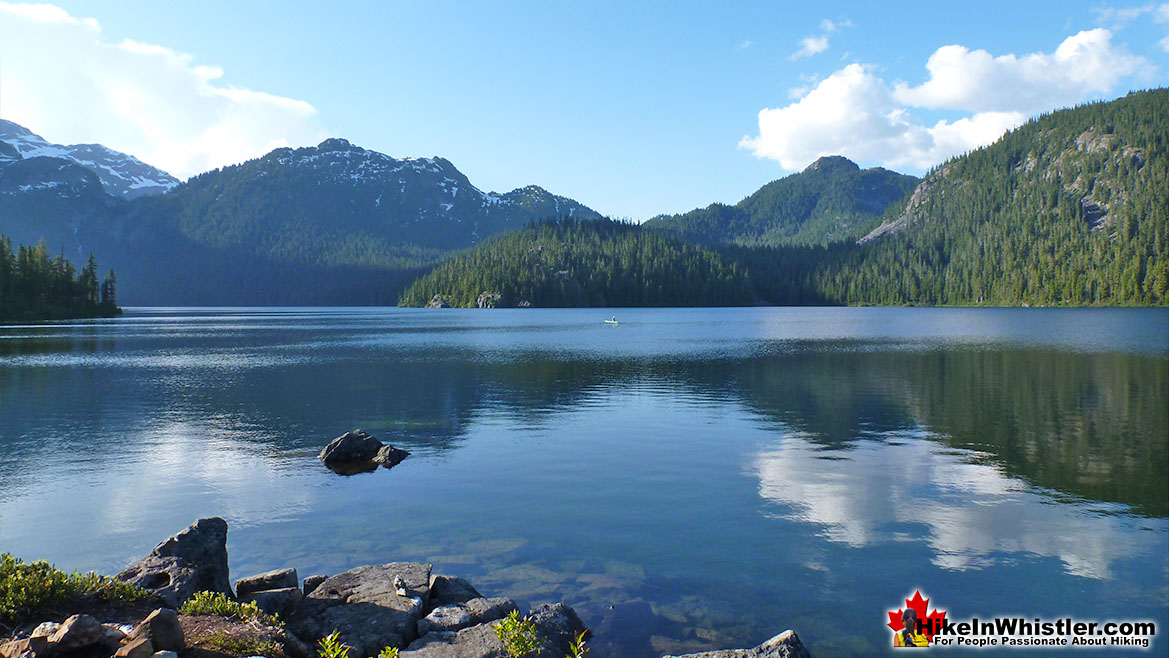
Finding the Cirque Lake Trailhead
![]() Once in the water, navigating to the unmarked Cirque Lake trailhead is easy. Callaghan Lake fills the huge valley for about 2.6 kilometres(1.6 miles), and you simply paddle to the far end of the lake. Expect to take 30-40 minutes and halfway along the way you will start hearing the distant crashing of Cirque Falls. You will also be able to see it, very tall and very narrow, a white strip of water coming down the near vertical cliffs. Nearing the end of Callaghan Lake aim for the point where the stream from the falls enter Callaghan Lake. There is a gravel bar built up from several water channels here and a large tree jutting out into the lake. This is the best spot to aim for as the unmarked trail starts just a few metres from here. It is easy to drag your canoe up to the small and idyllic campsite located just inside the forest here. A cute fire ring and log seat in a clearing that is almost impossibly scenic and much like Cirque Lake, feels far removed from civilisation. The trail snakes its way through a beautiful forest, always close to streams and within earshot of the crashing falls a few hundred metres to your left. After 15 minutes of relatively flat terrain the trail turns sharply upward as you begin the considerably steep ascent. You will be gaining over 300 metres(1000 feet) in the next hour, which doesn’t sound like much, however it is done in less than 2 kilometres(1.2 miles), trailhead to lake.
Once in the water, navigating to the unmarked Cirque Lake trailhead is easy. Callaghan Lake fills the huge valley for about 2.6 kilometres(1.6 miles), and you simply paddle to the far end of the lake. Expect to take 30-40 minutes and halfway along the way you will start hearing the distant crashing of Cirque Falls. You will also be able to see it, very tall and very narrow, a white strip of water coming down the near vertical cliffs. Nearing the end of Callaghan Lake aim for the point where the stream from the falls enter Callaghan Lake. There is a gravel bar built up from several water channels here and a large tree jutting out into the lake. This is the best spot to aim for as the unmarked trail starts just a few metres from here. It is easy to drag your canoe up to the small and idyllic campsite located just inside the forest here. A cute fire ring and log seat in a clearing that is almost impossibly scenic and much like Cirque Lake, feels far removed from civilisation. The trail snakes its way through a beautiful forest, always close to streams and within earshot of the crashing falls a few hundred metres to your left. After 15 minutes of relatively flat terrain the trail turns sharply upward as you begin the considerably steep ascent. You will be gaining over 300 metres(1000 feet) in the next hour, which doesn’t sound like much, however it is done in less than 2 kilometres(1.2 miles), trailhead to lake.
Cirque Lake Trailhead is Below Cirque Falls

Cirque Lake Trailhead Campsite Clearing
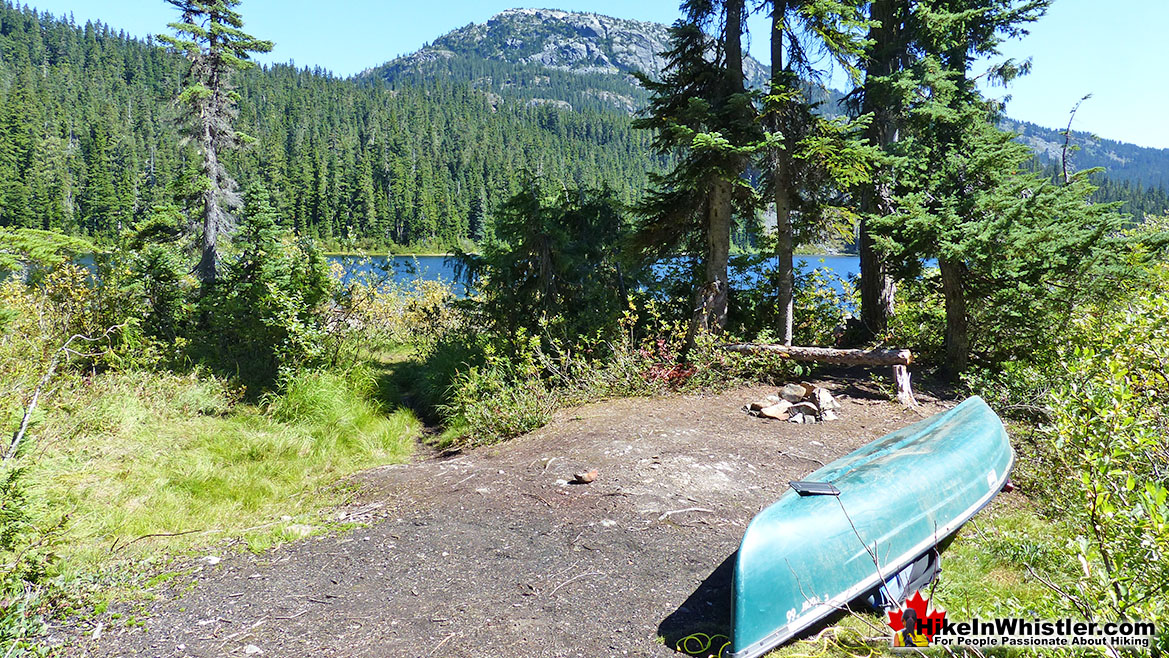
Cirque Lake Trail Runs Along and Over Cirque Creek
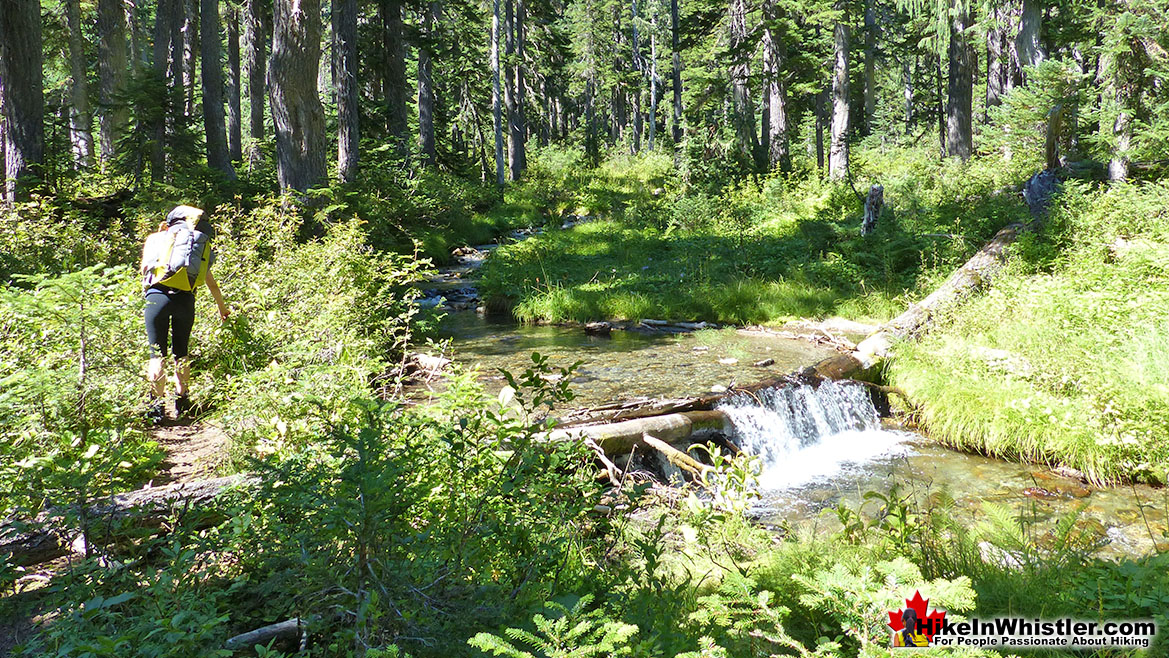
Cirque Lake Trail Boulder Field
Thirty minutes into the trail you will come to a startlingly violent looking boulder field filling the narrow valley in front of you. The trail here becomes fairly difficult to follow, however you need only focus on reaching the top end of the boulder field. Though the trail is marked with rock cairns and orange tape, the crushing weight of the previous winter’s snow will have swept many of them away. This is also the section of the trail where you will start taking endless stunning pictures of Callaghan Lake behind you. The deep blue lake filling the valley, green forest all around and Black Tusk surrounded by snowcapped mountains and glaciers. As you first emerge from the trees and into the boulder field you will cross to the right side, then up this side for about 50 metres before the route zigzags left(in 2015 there was a large fallen tree with orange tape on it laying across your route). After climbing part way back to the left side of the scree slope you should be able to make out some bright orange tape and/or some rock cairns marking the narrow end of the boulder field. This is where you are aiming and finally exit the boulder field into the forest. This is a tricky exit up into the forest requiring pulling yourself up the gap by clinging to hardy krummholz trees. This narrow gap into the forest opens up to a cliff on your right and a valley on your left where you can once again hear Cirque Falls. The trail sharply cuts right and up the cliff that moments ago looked impossible to climb. A well worn trail guides you up a few short and very steep sections to reach the top of the cliff.
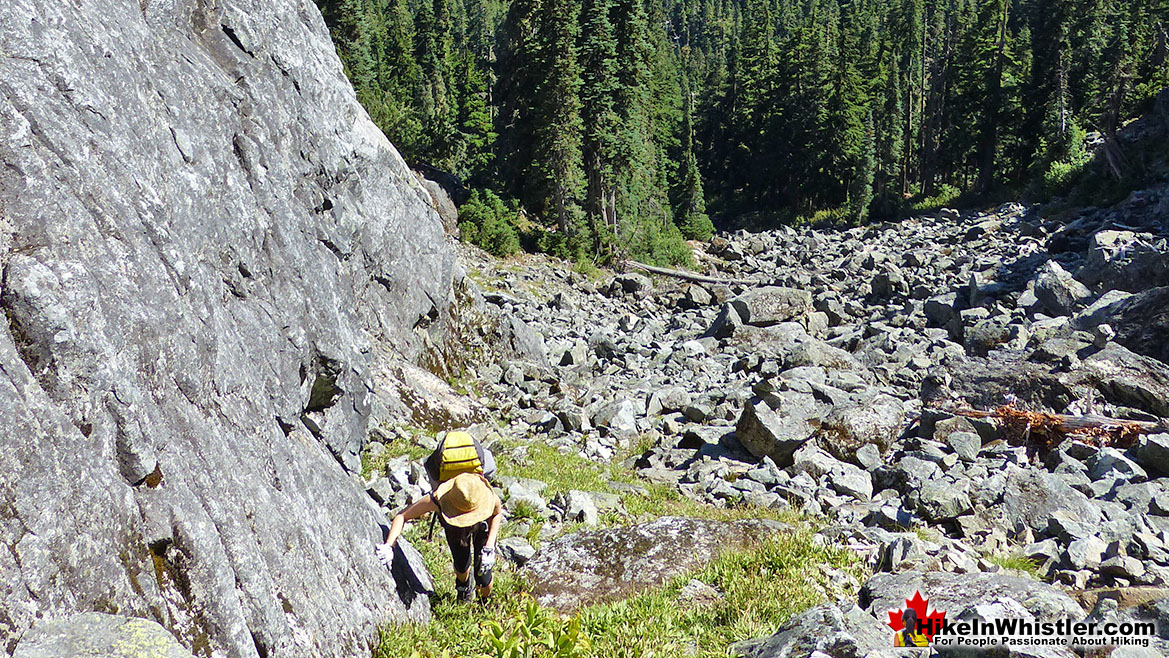

Callaghan Lake and Distant Whistler Mountain, Black Tusk and Mount Garibaldi
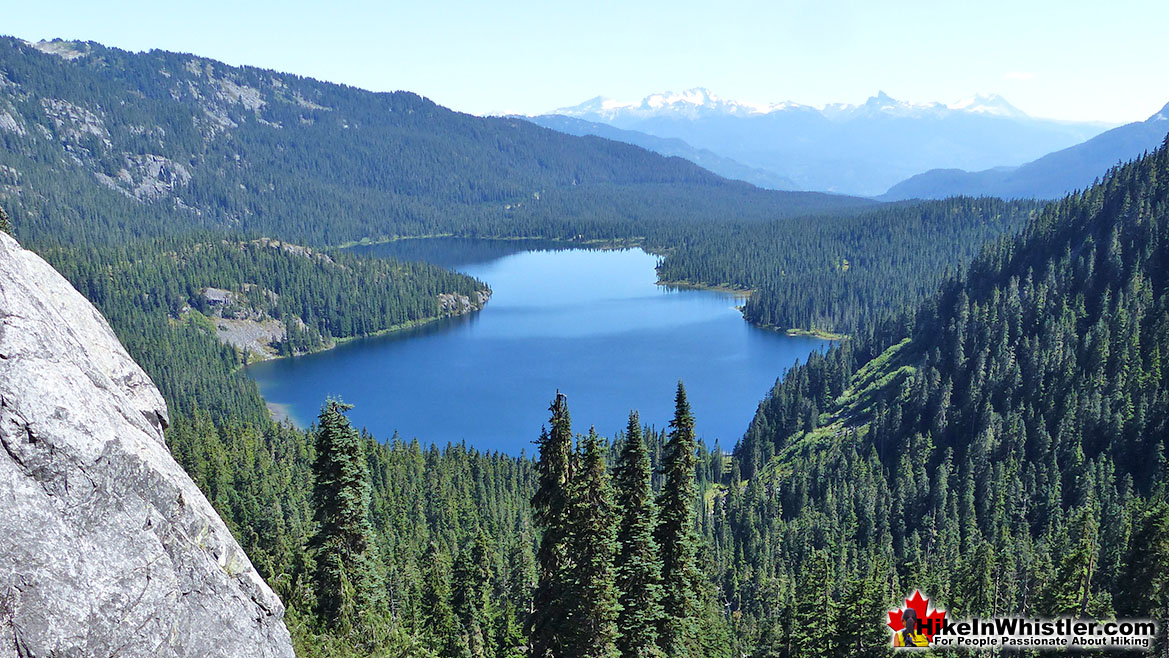
Amazing Views on the Cirque Lake Trail
This section should be manageable by most hikers, though you will have to pull yourself up some tricky sections. The top of the cliff opens to an even more amazing view of Callaghan Lake. Whistler Mountain, Black Tusk and now Mount Garibaldi can be made out on the horizon. The trail then ascends this beautiful ridge for just a couple hundred metres before descending quickly down another boulder field. Cirque Lake opens up into view and you come to a series of short rocky bluffs overlooking the lake. A trail leads you to a small clearing, perfect for a tent or two and home to a small fire ring. The lake is just another 50 metres down this rocky ridge. The tent area is a perfect combination of a flat dirt area and rocky protrusions with large and small trees all around. The view of Cirque Lake is wide open yet you can easily find shade on a hot day.

Callaghan Lake from the Cirque Lake Trail
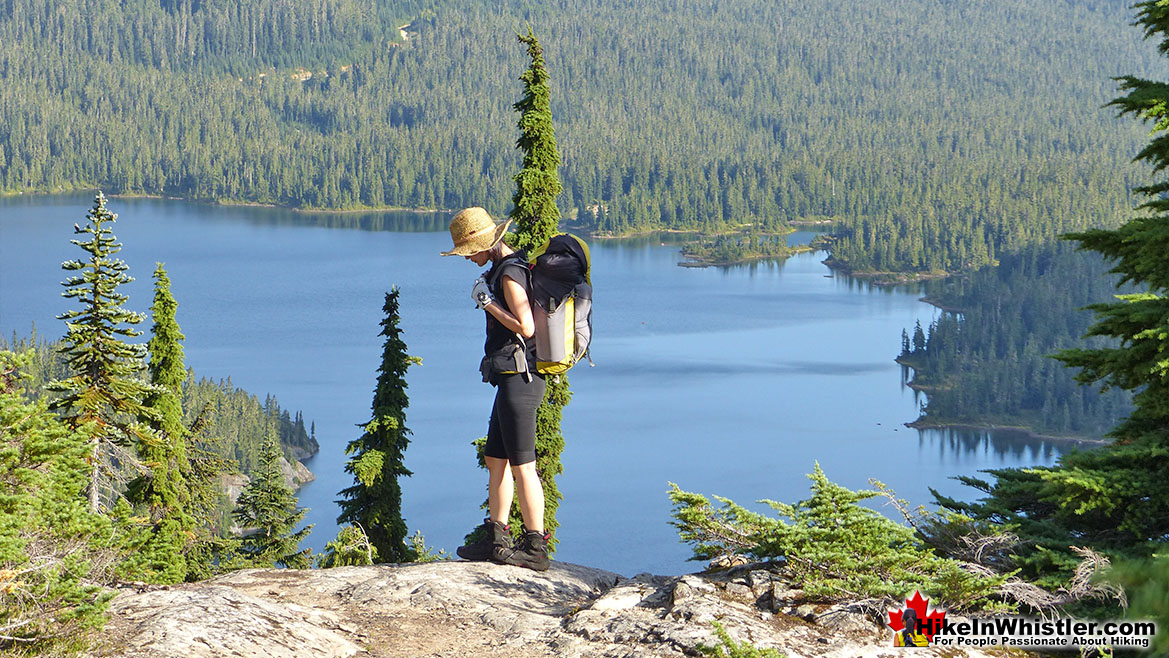
Arriving in Paradise at Cirque Lake
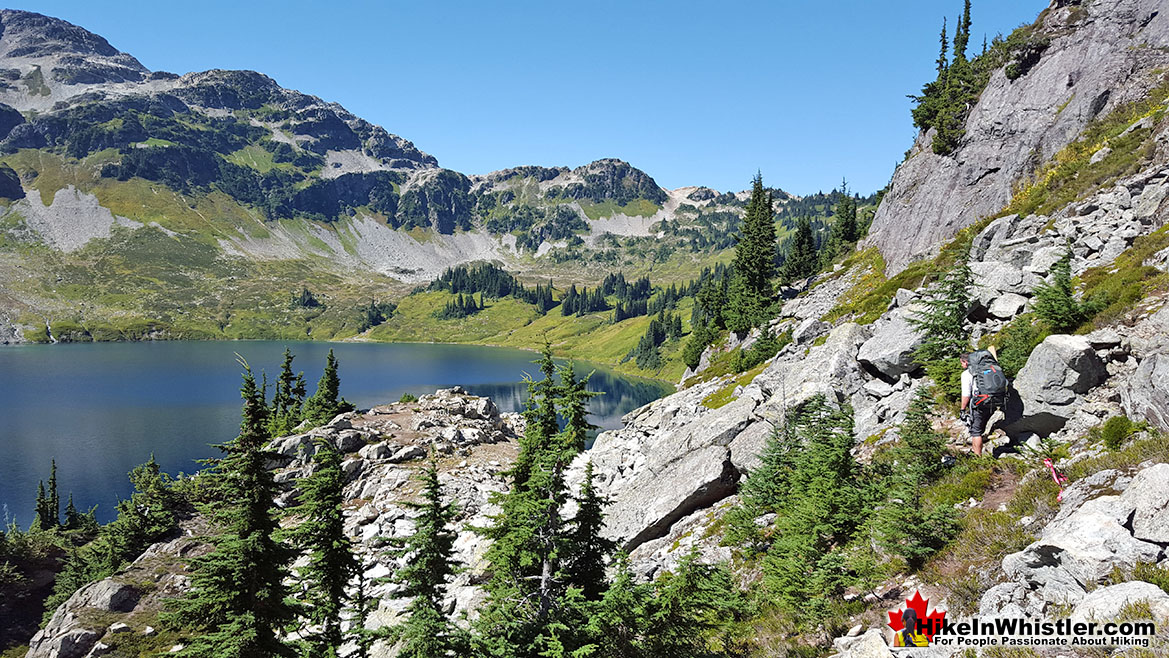
Incredible Tent Site at Cirque Lake
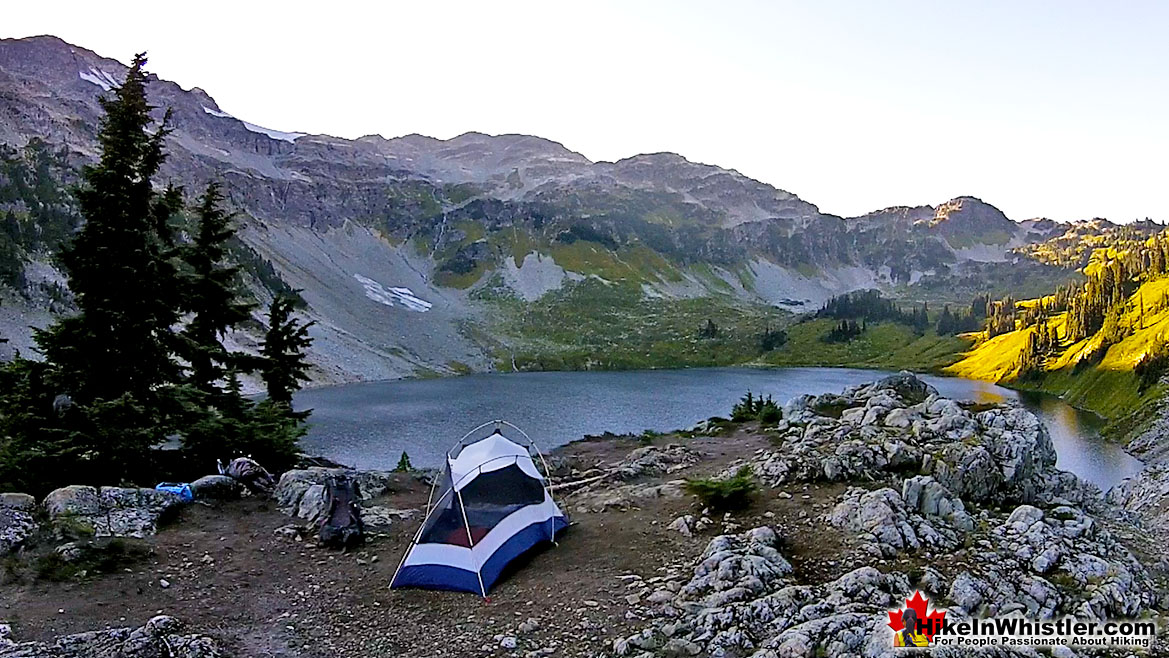
Sun Setting Over Cirque Lake
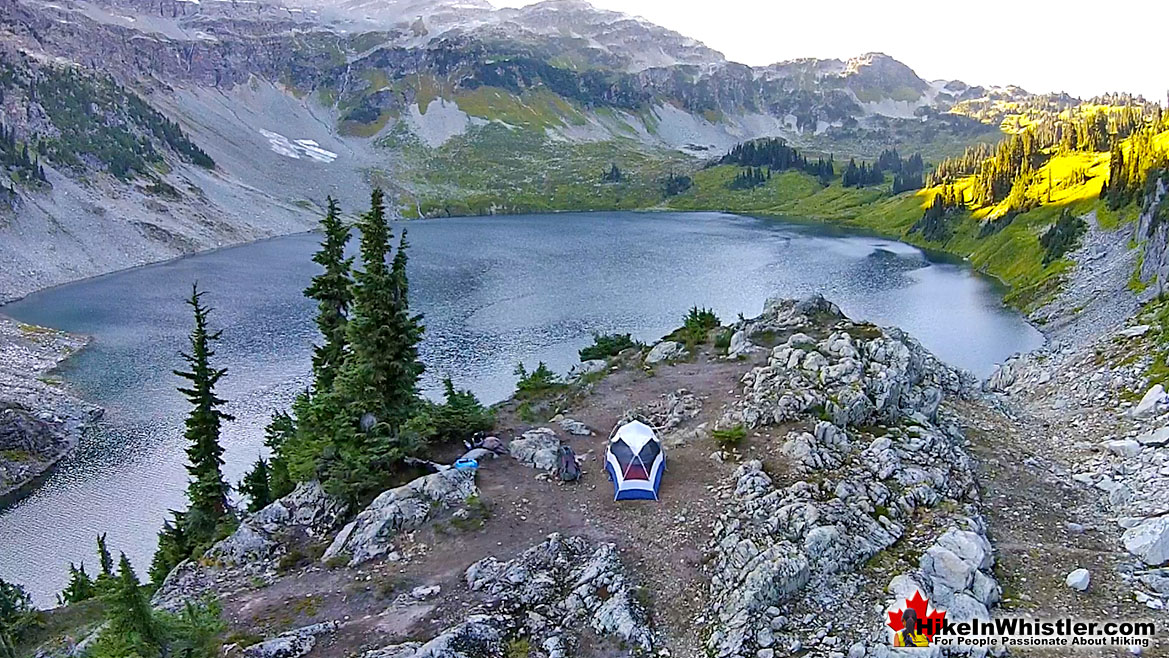
Cirque Lake Tent View

Cirque Lake From Above

Swimming at Cirque Lake
![]() Down at the lake you find a rocky shoreline and perfectly clear water, emerald green. You can jump right in from nearly everywhere as you quickly discover the lake is very deep. If you walk along the left side of the lake for a dozen metres you come to a rock outcrop a couple metres above the water that seems designed for lounging and jumping in. Jumping in Cirque Lake is almost a requirement as the water is shockingly cold even on a brutally hot August day. A perfectly arranged glacier is required to form a cirque lake. A magical combination of size, a certain sloping terrain, and more unexpectedly, a certain angle away from the sun. In the northern hemisphere, this means the glacier must be on the northeast slope of the mountain, away from the suns rays and the prevailing winds. Thick snow protected in this way grows thicker into glacial ice, then a process of freeze-thaw called nivation, chews at the lower rocks, hollowing out a deep basin. Over a thousand winters you are left with a magnificently circular lake with steep slopes all around. If you arrive at Cirque Lake, near Whistler, BC on a favorably sunny, summer day, you will almost certainly fall silent, gaze in wonder at this spectacular place, and feel in that moment that this place is as perfect as it is possible for a place to be.
Down at the lake you find a rocky shoreline and perfectly clear water, emerald green. You can jump right in from nearly everywhere as you quickly discover the lake is very deep. If you walk along the left side of the lake for a dozen metres you come to a rock outcrop a couple metres above the water that seems designed for lounging and jumping in. Jumping in Cirque Lake is almost a requirement as the water is shockingly cold even on a brutally hot August day. A perfectly arranged glacier is required to form a cirque lake. A magical combination of size, a certain sloping terrain, and more unexpectedly, a certain angle away from the sun. In the northern hemisphere, this means the glacier must be on the northeast slope of the mountain, away from the suns rays and the prevailing winds. Thick snow protected in this way grows thicker into glacial ice, then a process of freeze-thaw called nivation, chews at the lower rocks, hollowing out a deep basin. Over a thousand winters you are left with a magnificently circular lake with steep slopes all around. If you arrive at Cirque Lake, near Whistler, BC on a favorably sunny, summer day, you will almost certainly fall silent, gaze in wonder at this spectacular place, and feel in that moment that this place is as perfect as it is possible for a place to be.
Shoreline View of Cirque Lake
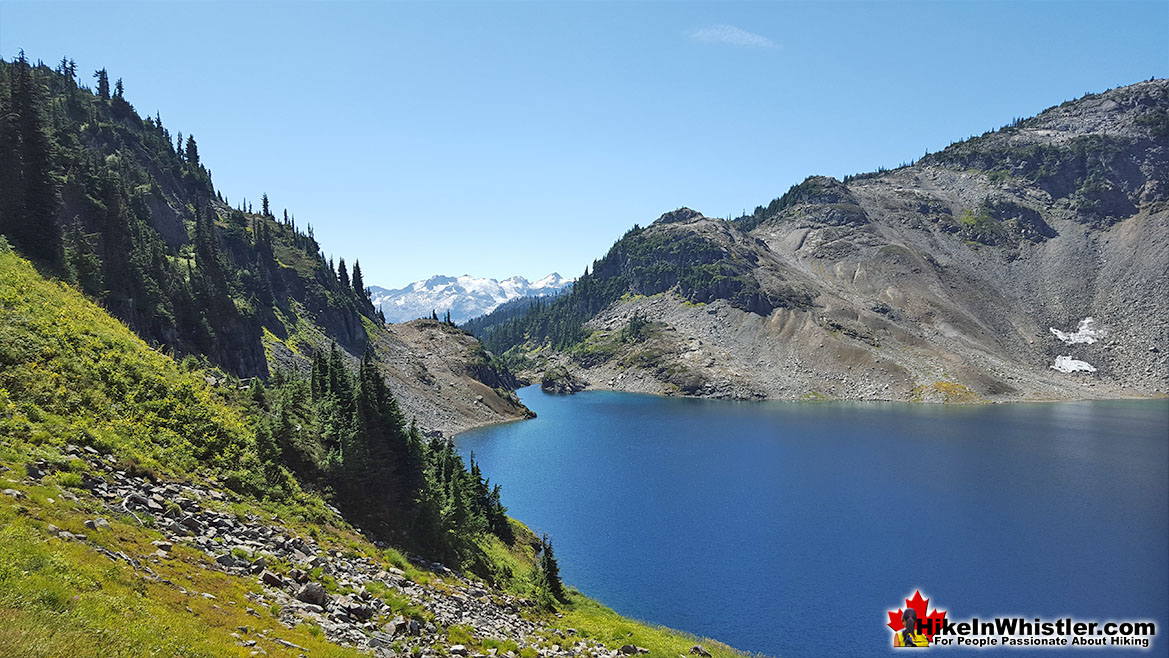
Alpine View of Cirque Lake and Mount Callaghan
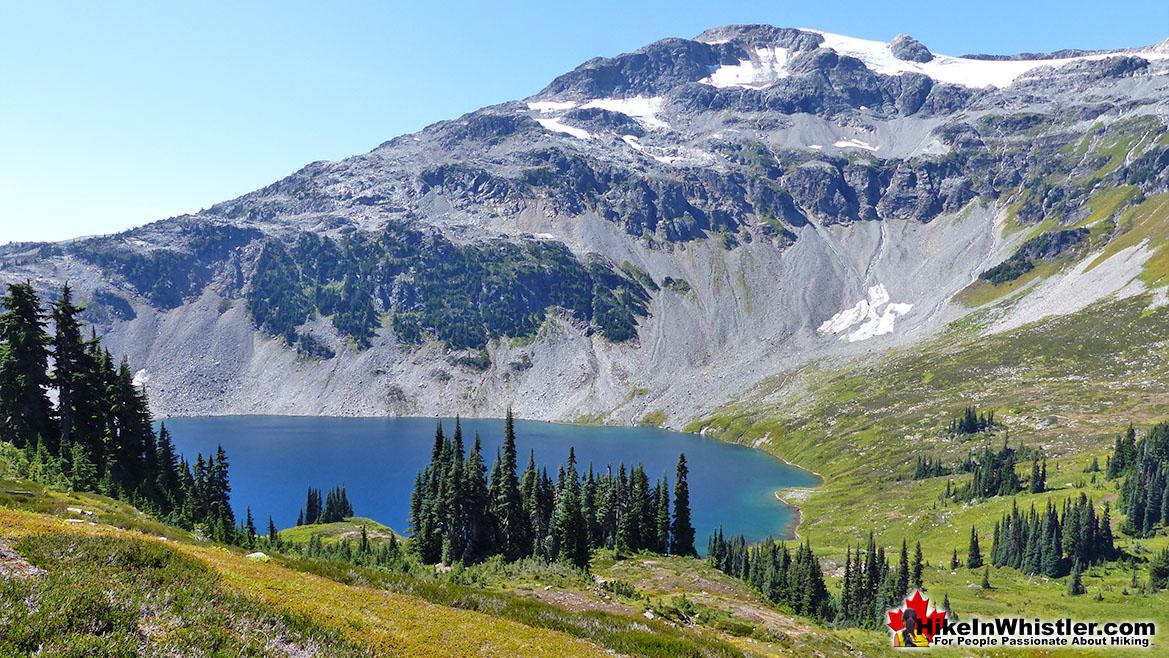
Aerial View of Cirque Lake and Mount Callaghan
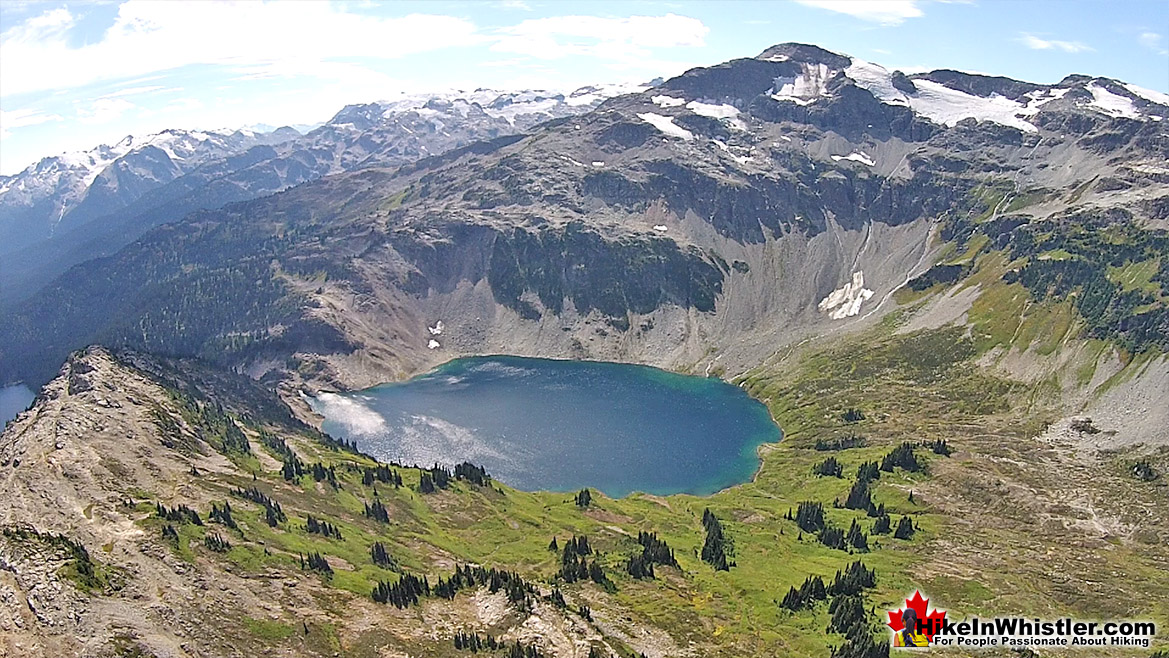
Cirque Lake Trail Map
![]() Callaghan Lake Provincial Park encompasses quite a large area, however the campground on the lake is what most perceive to be the park. In fact the park stretches far beyond the end of the lake and to encompass Cirque Lake and Telemagique Lake. Both lakes are stunning, however only Cirque Lake has a marked trail to it. Telemagique is accessible via a fairly easy route that starts at the parking area for Madeley Lake campground. Callaghan Lake itself doesn't have any trails beyond the very short bits at the campground. There is a route around the right side of the lake. It is overgrown at the start, but opens up as you round the first bend. The Cirque Lake trail is very steep and short at just a couple kilometres. The trail starts at the far end of Callaghan Lake. Be careful as this trail is easy to lose at times and especially in low light. Be prepared or you may end up lost on a cliff in the dark. The unmarked Ring & Conflict Lake trailhead starts just outside the Callaghan Lake campground. Ring Lake is a very pretty and remote lake with a peak similar to Black Tusk. Little Ring Mountain is a little brother to Black Tusk across the valley, with its similar structure and stark black colour.
Callaghan Lake Provincial Park encompasses quite a large area, however the campground on the lake is what most perceive to be the park. In fact the park stretches far beyond the end of the lake and to encompass Cirque Lake and Telemagique Lake. Both lakes are stunning, however only Cirque Lake has a marked trail to it. Telemagique is accessible via a fairly easy route that starts at the parking area for Madeley Lake campground. Callaghan Lake itself doesn't have any trails beyond the very short bits at the campground. There is a route around the right side of the lake. It is overgrown at the start, but opens up as you round the first bend. The Cirque Lake trail is very steep and short at just a couple kilometres. The trail starts at the far end of Callaghan Lake. Be careful as this trail is easy to lose at times and especially in low light. Be prepared or you may end up lost on a cliff in the dark. The unmarked Ring & Conflict Lake trailhead starts just outside the Callaghan Lake campground. Ring Lake is a very pretty and remote lake with a peak similar to Black Tusk. Little Ring Mountain is a little brother to Black Tusk across the valley, with its similar structure and stark black colour.
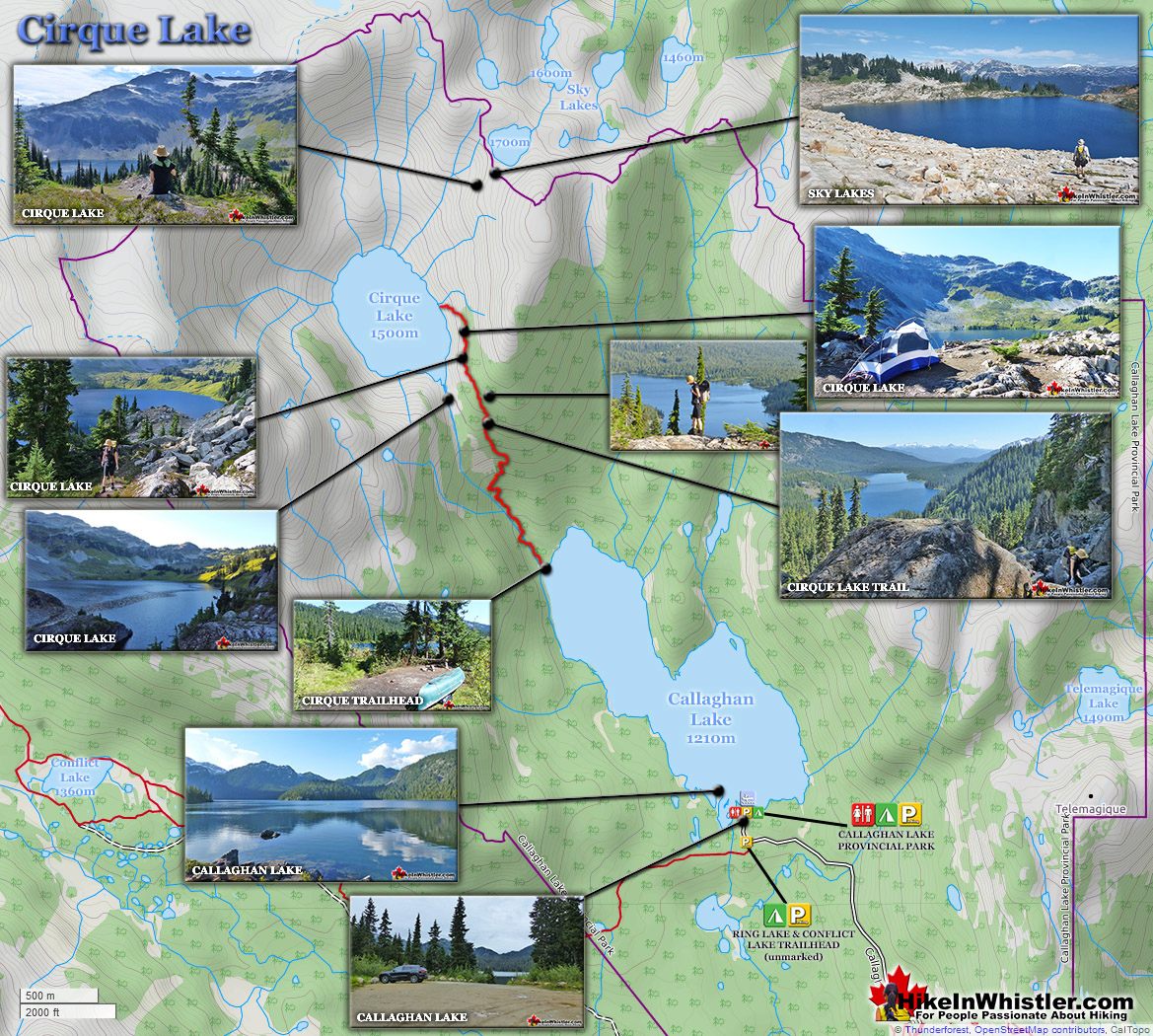
History of Cirque Lake
![]() Callaghan Lake Provincial Park has a colourful history. Back in the 1980's BCParks had their eye on creating a 100 square kilometre park around Callaghan Lake. At the same time a plan to build a ski resort was in the works. The ski resort plans were derailed by government intervention and in 1997 Callaghan Lake Provincial Park was established. The original 100 square kilometre plan was reduced to just 26.67 square kilometres. At Alexander Falls, just before the turnoff to the 8 kilometre logging road to Callaghan Lake there is a bit of history of the area to see. At the falls viewing area/parking lot there is a nice information board with as short history of the areas surrounding Alexander Falls, complete with museum-like pictures of the regions logging history. One depicts, "A Land of Giants" and describes, with photos, how incredibly huge trees were cut down and moved. One picture from 1910, shows 10 men sitting on an enormous, felled tree and looking tiny by comparison. The depiction goes on to show how First Nations people felled trees as long as 8000 years ago. The history of logging continues to present day logging practices in British Columbia and around Whistler are depicted in another nice museum-like mural on BC's "Green Advantage" and sustainable future. The drive to Alexander Falls is very nice. As soon as you turn off from the Sea to Sky Highway into the Callaghan Valley you ascend quickly into the mountains. Bears along the roadside are frequently seen as they seem to have a particular fondness for the fields of grass that grow in the sunny meadows that surround this recently constructed, paved road. On the viewing platform there is a memorial plaque that reads: "In Memory of F/O Gerald S. Stubbs and F/O James E. Miller. Members of 409 Squadron who perished in this area on 22 March 1956." This memorial refers to a mysterious plane crash of a Canadian fighter plane who's occupants have never been found. For several years it was thought that the plane went down in the Pacific as it was flying over from Vancouver Island on a routine training flight in a T-33 Silver Star. Indeed, the search took place over an area 32 kilometres northeast of Comox(Vancouver Island). A considerable distance from where you are at Alexander Falls. The search eventually wrapped up with the assumption that the plane went down in the ocean.
Callaghan Lake Provincial Park has a colourful history. Back in the 1980's BCParks had their eye on creating a 100 square kilometre park around Callaghan Lake. At the same time a plan to build a ski resort was in the works. The ski resort plans were derailed by government intervention and in 1997 Callaghan Lake Provincial Park was established. The original 100 square kilometre plan was reduced to just 26.67 square kilometres. At Alexander Falls, just before the turnoff to the 8 kilometre logging road to Callaghan Lake there is a bit of history of the area to see. At the falls viewing area/parking lot there is a nice information board with as short history of the areas surrounding Alexander Falls, complete with museum-like pictures of the regions logging history. One depicts, "A Land of Giants" and describes, with photos, how incredibly huge trees were cut down and moved. One picture from 1910, shows 10 men sitting on an enormous, felled tree and looking tiny by comparison. The depiction goes on to show how First Nations people felled trees as long as 8000 years ago. The history of logging continues to present day logging practices in British Columbia and around Whistler are depicted in another nice museum-like mural on BC's "Green Advantage" and sustainable future. The drive to Alexander Falls is very nice. As soon as you turn off from the Sea to Sky Highway into the Callaghan Valley you ascend quickly into the mountains. Bears along the roadside are frequently seen as they seem to have a particular fondness for the fields of grass that grow in the sunny meadows that surround this recently constructed, paved road. On the viewing platform there is a memorial plaque that reads: "In Memory of F/O Gerald S. Stubbs and F/O James E. Miller. Members of 409 Squadron who perished in this area on 22 March 1956." This memorial refers to a mysterious plane crash of a Canadian fighter plane who's occupants have never been found. For several years it was thought that the plane went down in the Pacific as it was flying over from Vancouver Island on a routine training flight in a T-33 Silver Star. Indeed, the search took place over an area 32 kilometres northeast of Comox(Vancouver Island). A considerable distance from where you are at Alexander Falls. The search eventually wrapped up with the assumption that the plane went down in the ocean.

Two decades later, in the early 1970's, a hiker named Howard Rode found the canopy of the long lost T-33 high up on Mt Callaghan. Rode wrote down the serial number off the canopy and notified the military, who were surprised to discover was the canopy of Stubbs and Miller's plane. A search of the area found no other wreckage. Not surprising if you have hiked in the area. The terrain is a chaotic mix of deep forest, steep terrain, and a maze of enormous erratics and fallen trees. In this type of terrain, you can rarely make out landmarks or get a clear sight of where you are going. Searching the area is extremely difficult and the search area that seems small on paper, is monstrous on the ground. It took two more decades for another clue to be found. In 1997 a member of Whistler Search and Rescue spotted plane wreckage as he flew over the area. Four kilometres south and down the valley of where the original canopy was found! Finally, the wreckage could be examined for clues to what had happened. The cause was determined to be fuel starvation. No sign of Stubbs and Miller were found, despite a lot of searching. Another decade would pass before a clue to the two missing airmen was found. A helmet was found directly between the wreckage and the canopy. Just a helmet. Another set of searches went on, and remarkably, still nothing else found. Somewhere between the wreckage and the canopy, the ejected seats of the fighter plane still lay hidden. Pilots eject from a T-33 with the seats and parachute down to safety. It now seemed evident that Stubbs and Miller ejected the plane before it crashed and possibly survived. Surviving the crash may have been the easy part. Finding civilisation over brutal terrain, deep with snow and in freezing winter temperatures. In March 1956, just like most years, the snow on Mt Callaghan is measured in metres. Eventually another clue will be found as hiking trails continue to be developed in the area and the number of hikers combing the dense forest increase.
Geology of Cirque Lake
![]() A cirque is a glacier-carved bowl or amphitheater in the mountains. To form, the glacier must be a combination of size, a certain slope and more unexpectedly, a certain angle away from the sun. In the northern hemisphere, this means the glacier must be on the northeast slope of the mountain, away from the suns rays and the prevailing winds. Thick snow, protected in this way, grows thicker into glacial ice, then a process of freeze-thaw called nivation, chews at the lower rocks, hollowing out a deep basin. Eventually a magnificently circular lake is formed with steep sloping sides all around. Cirque Lake in Whistler is a wonderful example of a cirque lake.
A cirque is a glacier-carved bowl or amphitheater in the mountains. To form, the glacier must be a combination of size, a certain slope and more unexpectedly, a certain angle away from the sun. In the northern hemisphere, this means the glacier must be on the northeast slope of the mountain, away from the suns rays and the prevailing winds. Thick snow, protected in this way, grows thicker into glacial ice, then a process of freeze-thaw called nivation, chews at the lower rocks, hollowing out a deep basin. Eventually a magnificently circular lake is formed with steep sloping sides all around. Cirque Lake in Whistler is a wonderful example of a cirque lake.
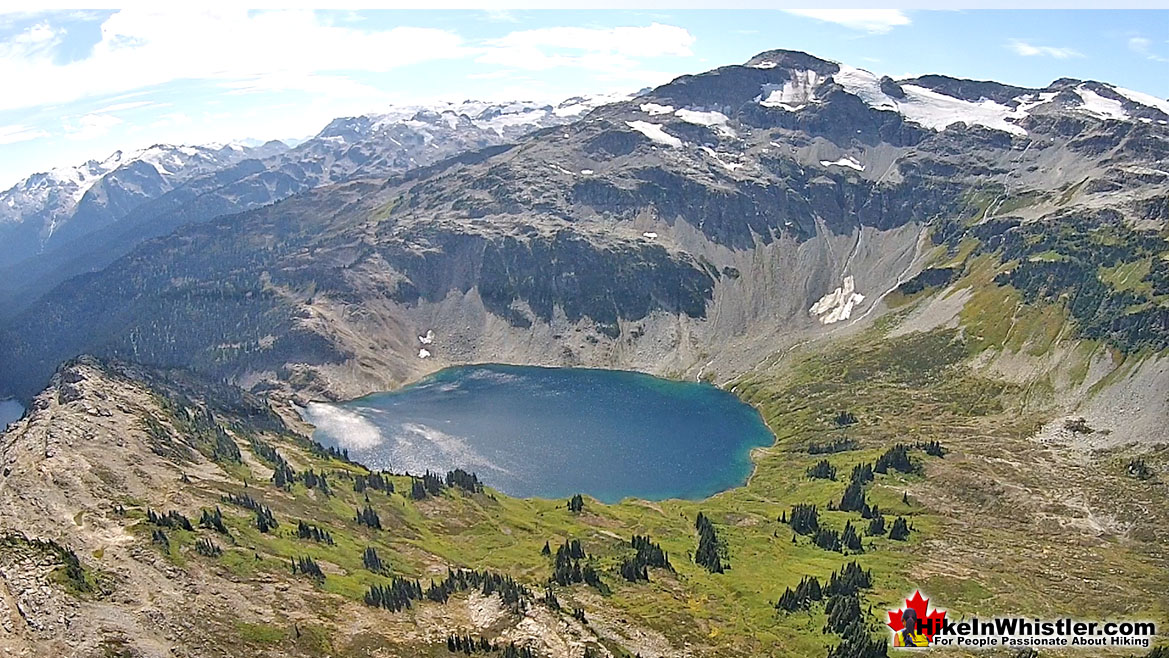
Camping & Bivouacking at Cirque Lake
![]() At the lake finding a piece of ground suitable for a tent is hard, though two can be found with a little bit of looking. One in the gap in the cliffs where the lake first spills out, and another high up on the ridge you hiked in from(pictured above). Both are equally spectacular, and you will quickly notice an incredible phenomenon of the cirque. The wonderful stillness of the air. The cold mountain winds often don't penetrate the cirque, yet the sunshine pours in. Outside the cirque you will need a jacket and sweater on a summer day. Inside it's the warm, serene shelter of paradise.
At the lake finding a piece of ground suitable for a tent is hard, though two can be found with a little bit of looking. One in the gap in the cliffs where the lake first spills out, and another high up on the ridge you hiked in from(pictured above). Both are equally spectacular, and you will quickly notice an incredible phenomenon of the cirque. The wonderful stillness of the air. The cold mountain winds often don't penetrate the cirque, yet the sunshine pours in. Outside the cirque you will need a jacket and sweater on a summer day. Inside it's the warm, serene shelter of paradise.
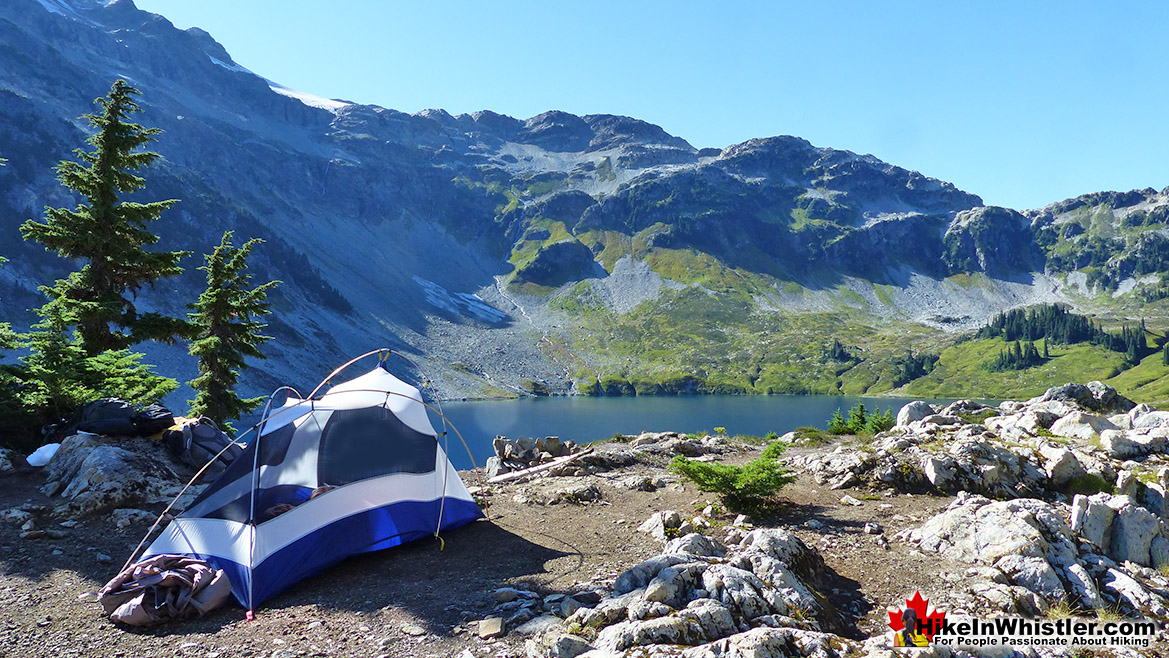
Facilities at Callaghan Lake & Cirque Lake
![]()
![]() Cirque Lake has no facilities such as picnic tables or outhouses. Callaghan Lake has outhouses and picnic tables as well as several well laid out, drive to campsites. As Callaghan Lake Provincial Park is still a free campsite and you won't find any elaborate amenities. There is a gravel slope in the campground, perfect for sliding a canoe into the crystal clear water. There are several well laid out tent sites adjacent to parking. Car camping is a much loved pastime with Canadians, and you will always find it going on at Callaghan Lake. There are good outhouses in the campground. The amenities are few, which has the added benefit of keeping the place wild and natural. As you slide into the water and are invariably astonished at the impossibly clear, light green water. Swimming in Callaghan Lake is always very cold, however you can float in a canoe, kayak, paddleboard, etc for hours. Just metres from the launch you see nothing but a perfect alpine lake and bright green forest leading up to snowy mountain peaks. The only signs of humanity disappear behind the trees moments after you move from the campground. Cirque Lake is even more astoundingly untouched. The rough and tough trail is faint at best, and at Cirque Lake you won't see a hint of previous visitors, except one small little fire ring near the shore.
Cirque Lake has no facilities such as picnic tables or outhouses. Callaghan Lake has outhouses and picnic tables as well as several well laid out, drive to campsites. As Callaghan Lake Provincial Park is still a free campsite and you won't find any elaborate amenities. There is a gravel slope in the campground, perfect for sliding a canoe into the crystal clear water. There are several well laid out tent sites adjacent to parking. Car camping is a much loved pastime with Canadians, and you will always find it going on at Callaghan Lake. There are good outhouses in the campground. The amenities are few, which has the added benefit of keeping the place wild and natural. As you slide into the water and are invariably astonished at the impossibly clear, light green water. Swimming in Callaghan Lake is always very cold, however you can float in a canoe, kayak, paddleboard, etc for hours. Just metres from the launch you see nothing but a perfect alpine lake and bright green forest leading up to snowy mountain peaks. The only signs of humanity disappear behind the trees moments after you move from the campground. Cirque Lake is even more astoundingly untouched. The rough and tough trail is faint at best, and at Cirque Lake you won't see a hint of previous visitors, except one small little fire ring near the shore.
The Top of Cirque Falls
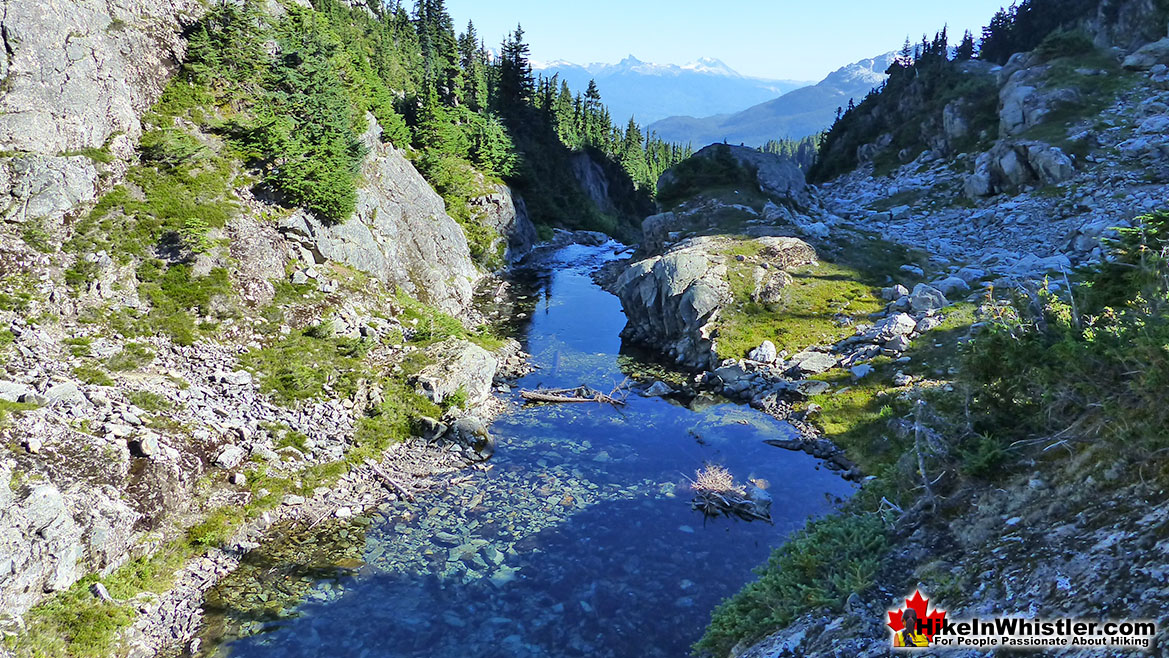
Restrictions and Concerns in Callaghan Lake Provincial Park
![]() Callaghan Lake Provincial Park is a wild and mostly untouched wilderness with no restrictions. There is a fire ban most of the summer in and around Whistler to help prevent forest fires, however there are several fire rings at the campsite. But having a fire elsewhere is prohibited. Dogs are welcome and fishing is quite popular here. Callaghan Lake and Cirque Lake were stocked with rainbow trout back in 1972 and flyfishing the far shores are popular. Keep in mind that the access road to Callaghan Lake Provincial Park is gated until the 15th of May every year as the area is pay to use in the winter. The rest of the year it is wonderfully free.
Callaghan Lake Provincial Park is a wild and mostly untouched wilderness with no restrictions. There is a fire ban most of the summer in and around Whistler to help prevent forest fires, however there are several fire rings at the campsite. But having a fire elsewhere is prohibited. Dogs are welcome and fishing is quite popular here. Callaghan Lake and Cirque Lake were stocked with rainbow trout back in 1972 and flyfishing the far shores are popular. Keep in mind that the access road to Callaghan Lake Provincial Park is gated until the 15th of May every year as the area is pay to use in the winter. The rest of the year it is wonderfully free.
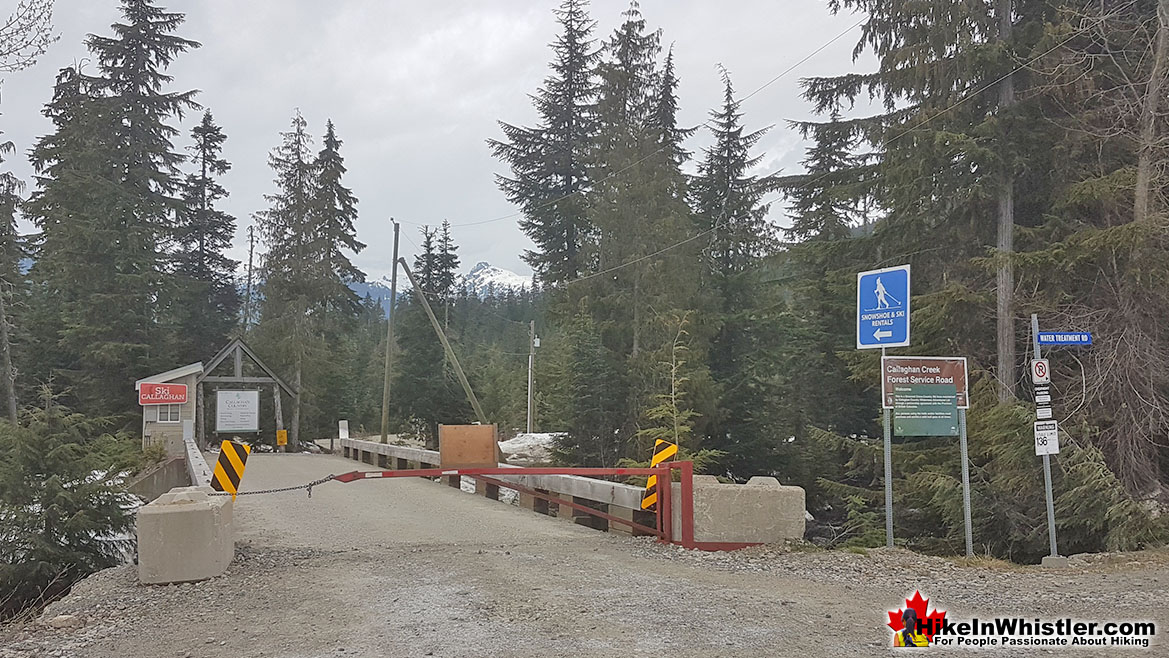
Wildlife in Callaghan Lake Provincial Park
![]() Callaghan Lake Provincial Park and Cirque Lake are very dog friendly. The area is fairly quiet, especially compared to the hectic Garibaldi Provincial Park across the valley, where dogs are prohibited. The trail to Cirque Lake is very steep, so you have to consider that when thinking of bringing your dog. If you and your dog are OK with a few spots where he will need a boost, then you should be fine bringing him along. Though the campsite at Callaghan Lake is occasionally busy, Cirque Lake, owing to its difficult access, should be devoid of people. The Callaghan Valley is grizzly bear territory, and though bear/human conflicts are virtually unknown here, it is worth keeping in mind on the trail. Sightings are very rare, so count yourself lucky if you spot a grizzly and are quick enough to snap a photo. If you are used to seeing black bears around Whistler, the tell-tale, large hump on the back of a grizzly's neck will give you quite a shock. Wildlife in the Callaghan Valley is fantastically varied. Owing to the fact that it lays on the quieter side of Whistler and its location in an extensive wilderness, means few BC animals don't live here. If you take a look at Cirque Lake on Google Earth, and zoom out, you see the vast wilderness stretching to the ocean. Because of this, you are far more likely to encounter a grizzly bear in the Callaghan Valley, than at Garibaldi Lake, for example. The good news(or bad news) is that you are still not likely to see one. Grizzly bear encounters are so rare in and around Whistler and surrounding mountains, that most years only see a distant snapshot of a grizzly taken by an excited tour guide or lucky hiker. The problem with rarely seeing grizzlies, is that you forget they are out there. Grizzles are far more dangerous than black bears. Black bears are extremely retiring and Whistler has never had an unprovoked bear attack, ever. Every couple years someone comes home to find a bear found their way into their house and frightened, charges and claws them as they escape. Grizzlies on the other hand, are much more likely to become aggressive when encountering humans. Though you will likely never encounter a grizzly in the park, you will occasionally see a black bear. Often one crosses your path on the drive up, and less frequently you see one on the trail or around Callaghan Lake. An animal you are almost guaranteed to find at Cirque Lake is the adorable hoary marmot. If you hike up the grassy and rocky sloping meadow adjacent to Cirque Lake you will nearly trip over them. Whistling unseen and ducking in and out of the rocky terrain, there are several hoary marmots that lurk in this ideal marmot habitat. Other animals that roam this vast wilderness, yet are rarely spotted are wolverines, moose, mountain goats, bobcats, coyotes, minks, and somewhat more often, black-tailed deer.
Callaghan Lake Provincial Park and Cirque Lake are very dog friendly. The area is fairly quiet, especially compared to the hectic Garibaldi Provincial Park across the valley, where dogs are prohibited. The trail to Cirque Lake is very steep, so you have to consider that when thinking of bringing your dog. If you and your dog are OK with a few spots where he will need a boost, then you should be fine bringing him along. Though the campsite at Callaghan Lake is occasionally busy, Cirque Lake, owing to its difficult access, should be devoid of people. The Callaghan Valley is grizzly bear territory, and though bear/human conflicts are virtually unknown here, it is worth keeping in mind on the trail. Sightings are very rare, so count yourself lucky if you spot a grizzly and are quick enough to snap a photo. If you are used to seeing black bears around Whistler, the tell-tale, large hump on the back of a grizzly's neck will give you quite a shock. Wildlife in the Callaghan Valley is fantastically varied. Owing to the fact that it lays on the quieter side of Whistler and its location in an extensive wilderness, means few BC animals don't live here. If you take a look at Cirque Lake on Google Earth, and zoom out, you see the vast wilderness stretching to the ocean. Because of this, you are far more likely to encounter a grizzly bear in the Callaghan Valley, than at Garibaldi Lake, for example. The good news(or bad news) is that you are still not likely to see one. Grizzly bear encounters are so rare in and around Whistler and surrounding mountains, that most years only see a distant snapshot of a grizzly taken by an excited tour guide or lucky hiker. The problem with rarely seeing grizzlies, is that you forget they are out there. Grizzles are far more dangerous than black bears. Black bears are extremely retiring and Whistler has never had an unprovoked bear attack, ever. Every couple years someone comes home to find a bear found their way into their house and frightened, charges and claws them as they escape. Grizzlies on the other hand, are much more likely to become aggressive when encountering humans. Though you will likely never encounter a grizzly in the park, you will occasionally see a black bear. Often one crosses your path on the drive up, and less frequently you see one on the trail or around Callaghan Lake. An animal you are almost guaranteed to find at Cirque Lake is the adorable hoary marmot. If you hike up the grassy and rocky sloping meadow adjacent to Cirque Lake you will nearly trip over them. Whistling unseen and ducking in and out of the rocky terrain, there are several hoary marmots that lurk in this ideal marmot habitat. Other animals that roam this vast wilderness, yet are rarely spotted are wolverines, moose, mountain goats, bobcats, coyotes, minks, and somewhat more often, black-tailed deer.
Parking & Trailhead Directions to Cirque Lake
![]() The trailhead to Cirque Lake is found at the far end of Callaghan Lake. Callaghan Lake Provincial Park is less than an hours drive from Whistler Village and most of the drive is quite beautiful. From Whistler drive 13.8 kilometres towards Vancouver on the Sea to Sky Highway. Turn right onto Callaghan Valley Road at the sign for Whistler Olympic Park. Drive up the beautiful, winding road for 9.6 kilometres. The sign for Callaghan Lake Provincial Park will be just after Alexander Falls Provincial Park and just before Whistler Olympic Park. You will turn left, cross a bridge and drive up the horrendously potholed Callaghan Lake FSR for 8.5 kilometres. Most vehicles can make it to the lake but with extreme caution and care at several waterbars and the frequent and very deep potholes. You often see full size motorhomes at the campsite so as long as you drive slow, most vehicles should make it slowly but surely. This logging road is usually deep with snow until June(June 4th in 2019). If you attempt to drive this road in early summer, be sure to bring a shovel and rope in case you find yourself stuck in the snow. You will have spotty cell reception all the way to the Callaghan campsite, however you may have to walk along the road until you catch a usable signal. Access to Callaghan Lake FSR is blocked by a chain at the bridge until May 15th every year. A huge pile of snow is plowed to block Callaghan Lake FSR just past the bridge. It keeps people from driving up and getting stuck in the snow on the higher elevations. When this snow pile melts, it is a good indication that the road to Callaghan Lake may be clear as well.
The trailhead to Cirque Lake is found at the far end of Callaghan Lake. Callaghan Lake Provincial Park is less than an hours drive from Whistler Village and most of the drive is quite beautiful. From Whistler drive 13.8 kilometres towards Vancouver on the Sea to Sky Highway. Turn right onto Callaghan Valley Road at the sign for Whistler Olympic Park. Drive up the beautiful, winding road for 9.6 kilometres. The sign for Callaghan Lake Provincial Park will be just after Alexander Falls Provincial Park and just before Whistler Olympic Park. You will turn left, cross a bridge and drive up the horrendously potholed Callaghan Lake FSR for 8.5 kilometres. Most vehicles can make it to the lake but with extreme caution and care at several waterbars and the frequent and very deep potholes. You often see full size motorhomes at the campsite so as long as you drive slow, most vehicles should make it slowly but surely. This logging road is usually deep with snow until June(June 4th in 2019). If you attempt to drive this road in early summer, be sure to bring a shovel and rope in case you find yourself stuck in the snow. You will have spotty cell reception all the way to the Callaghan campsite, however you may have to walk along the road until you catch a usable signal. Access to Callaghan Lake FSR is blocked by a chain at the bridge until May 15th every year. A huge pile of snow is plowed to block Callaghan Lake FSR just past the bridge. It keeps people from driving up and getting stuck in the snow on the higher elevations. When this snow pile melts, it is a good indication that the road to Callaghan Lake may be clear as well.

Deep Waterbars on the Callaghan Lake FSR
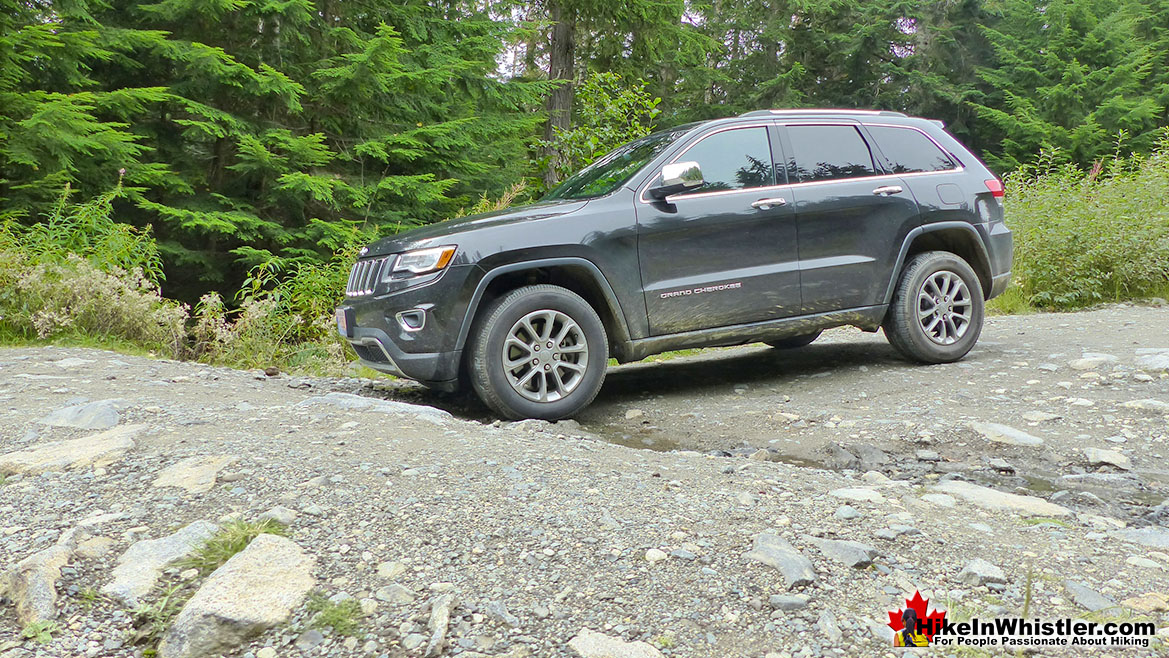
The Wonderfully Free Callaghan Lake Campsite
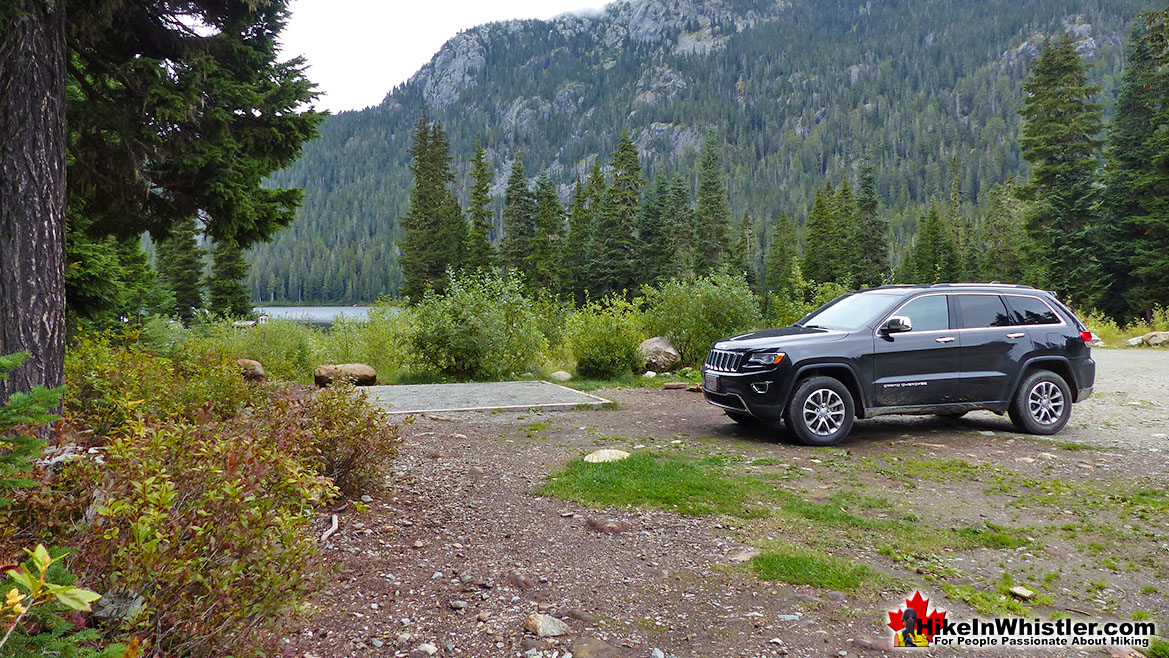
Finding the Cirque Lake Trailhead
![]() To reach the very hidden trailhead to Cirque Lake, paddle your canoe towards the waterfall far off in the distance. Not until you are only 50 metres from the shore, nearest the sound of the now hidden waterfall, you will see a small clearing jutting out from the shore, this is the trailhead, despite it not looking like one. Pull your canoe up here and drag into the bushes. Only a few metres into shore you will notice an obvious trail. There are even plenty of tree markers on the way. From here it is only an hour hike to the lake, though even steeper than the Wedgemount Lake trail. About two thirds of the way up the trail you will come to a massive boulder field. The trail emerges from the forest into this field and cuts across it. You then hike the precarious boulder field along the right side. The route zig-zags all the while following several not so obviously placed cairns and orange trail marker ribbons. At the top of the boulder field you will have to climb up a narrow cliff gap with an impressive array of brutalized krummholz trees. These boulder mangled trees, bent and twisted by the crushing weight of snow and rockfalls. From this gap to Cirque Lake is only another 15 minutes of ever more beautiful views.
To reach the very hidden trailhead to Cirque Lake, paddle your canoe towards the waterfall far off in the distance. Not until you are only 50 metres from the shore, nearest the sound of the now hidden waterfall, you will see a small clearing jutting out from the shore, this is the trailhead, despite it not looking like one. Pull your canoe up here and drag into the bushes. Only a few metres into shore you will notice an obvious trail. There are even plenty of tree markers on the way. From here it is only an hour hike to the lake, though even steeper than the Wedgemount Lake trail. About two thirds of the way up the trail you will come to a massive boulder field. The trail emerges from the forest into this field and cuts across it. You then hike the precarious boulder field along the right side. The route zig-zags all the while following several not so obviously placed cairns and orange trail marker ribbons. At the top of the boulder field you will have to climb up a narrow cliff gap with an impressive array of brutalized krummholz trees. These boulder mangled trees, bent and twisted by the crushing weight of snow and rockfalls. From this gap to Cirque Lake is only another 15 minutes of ever more beautiful views.
Whistler's Best Hiking Trails!
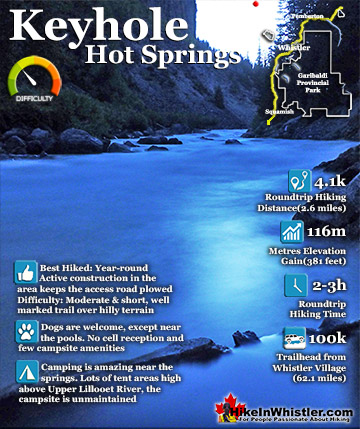

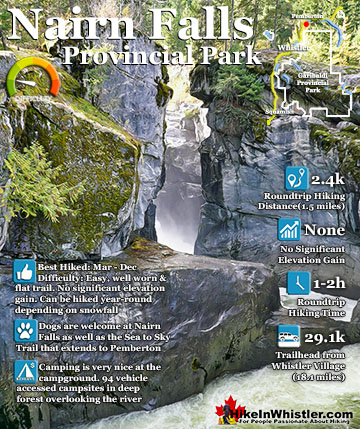
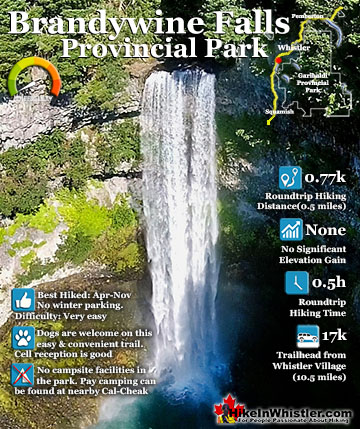
Whistler & Garibaldi Park Best Hiking by Month!




Explore BC Hiking Destinations!

Whistler Hiking Trails

Squamish Hiking Trails

Vancouver Hiking Trails

Clayoquot Hiking Trails

Victoria Hiking Trails



